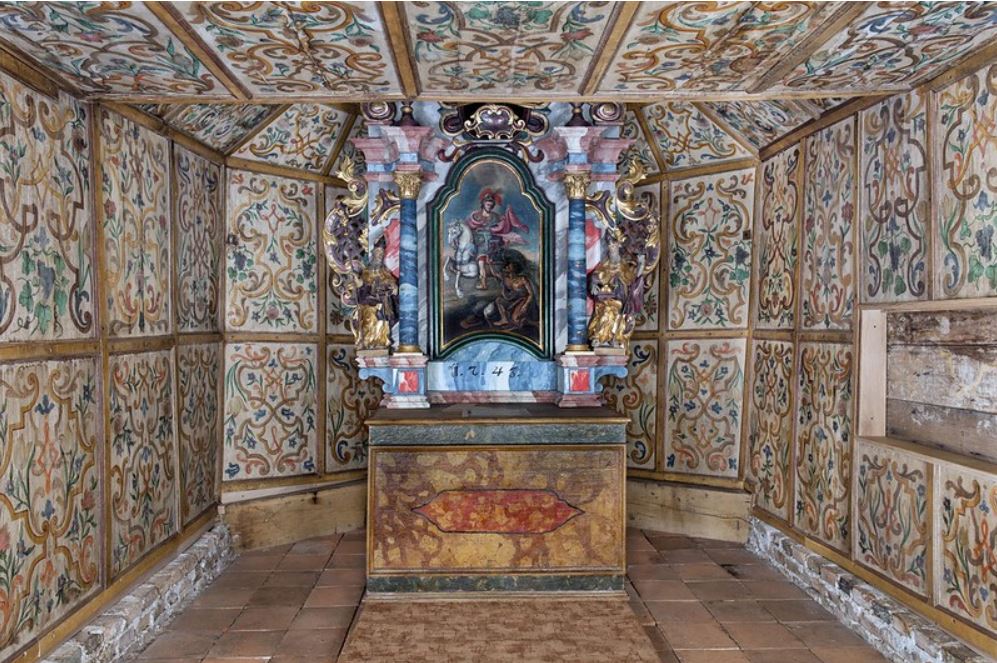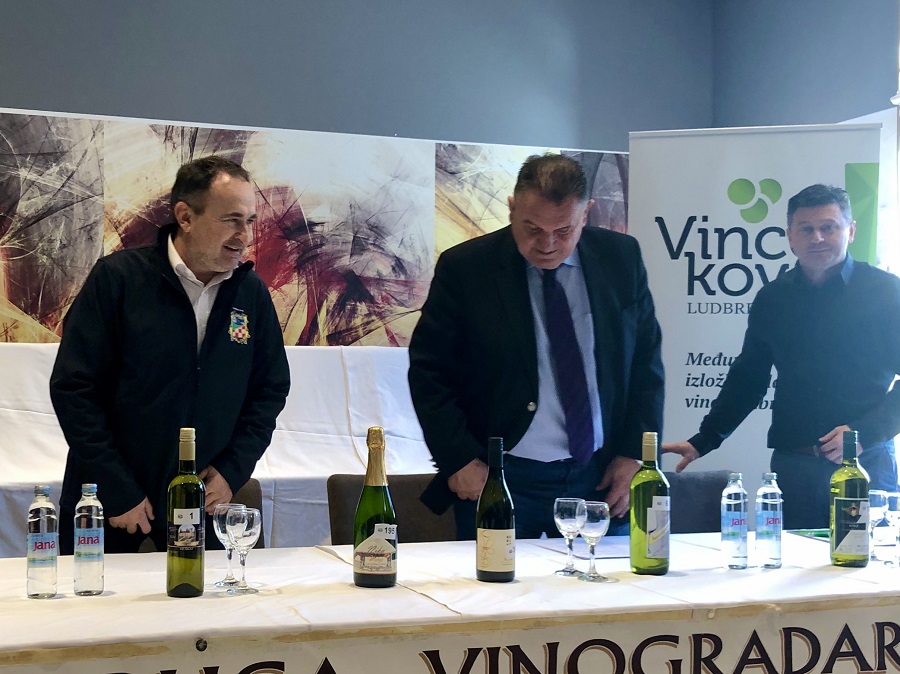One Minute Ludbreg: Croatian Government Delivers After 250 Years
July 31, 2020 - Meet One Minute Ludbreg, a new series highlighting the attractions of perhaps Croatia's most unusual town, each in a minute.
It is more than 4 years since I first visited the town of Ludbreg in Varazdin County, which I named at the time the most fascinating, unusual little town in Croatia.
And it really is.
Best known in Croatia for being the centre of the world, its real claim to fame (unknown to many people in Croatia) is that it is home to the only certified miracle in all Croatia.
And let's not forget the Ludbreg Restoration Centre, one of the leading restoration centres in Europe.
As well as...
Enough.
Ludbreg has a number of attractions, but they are hard to buttonhole into one place, as they are so diverse that they really need to be explained on their own.
So we came up with the idea of showcasing the 20 or so things of interest in Ludbreg - quite enough for a full day's sightseeing and overnight relaxation in the form of a video series called One Minute Ludbreg.
In an era of reduced budgets, but enhanced technology, perhaps this can become a working model for other destinations to showcase their points of interest for tourists.
In the first of this 20+ part series, meet the promise made by the Croatian Government back in 1738, which was only finally fulfilled in 1994, at the height of the Homeland War.
One Minute Ludbreg will be a regular TCN feature over the next ten weeks, with two videos a week. Next up, the reason with the chief restorer of the Sistine Chapel in the Vatican is a regular visitor to Ludbreg.
We hope you find the series interesting and informative, allowing you to discover things that you perhaps did not know about certain destinations. I was much encouraged in Dubrovnik last week when a business colleague told me he was from Dubrovnik, and that there was nothing an Irishman could tell him about his home town. After watching the first four videos, he took his words back.
Big thanks to Ludbreg Mayor Dubravko Bilic and Ludbreg Tourist Board Director Andrea Horvat for their full support and excellent assistance in arranging everything.
The One Minute Ludbreg video series is a project in paid partnership with the Ludbreg Tourist Board.
You can follow the One Minute Ludbreg YouTube channel here.
To learn more about Ludbreg, check out Marc Rowlands' piece on TCN - The Croatian Road Less Travelled: Ludbreg.
Visit Ludbreg on the Croatian Road Less Travelled
July 9, 2020 - Continuing the TCN series, The Croatian Road Less Travelled, Marc Rowlands explains why you should visit Ludbreg.
Situated in the far north of Croatia, just south-east of Varaždin and Čakovec and less than 20 kilometres from the border with Hungary, the small and picturesque town of Ludbreg is one of incredible contrasts and one with no small amount of ambition. Its close proximity to such neighbours pales into insignificance when you see the places Ludbreg would rather be judged against - this town is known as the Centre Of The World. The moniker was attributed when it was discovered, by accident, that it lies equidistant between many significant cities. Capitalising on the name, Ludbreg has charted these cities and their distance in a circular stone paving feature which can be found in the town's central square. 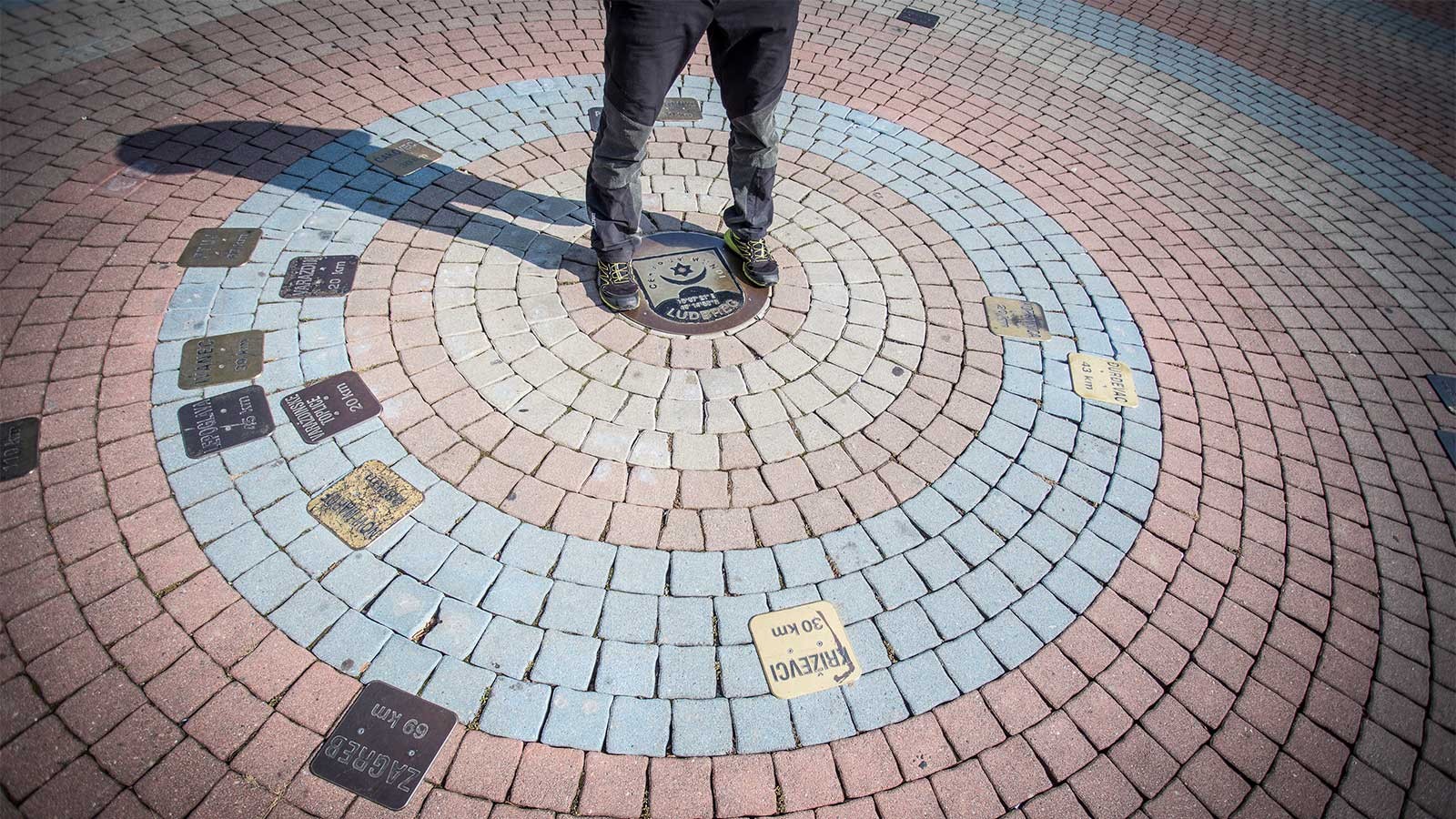
Visit Ludbreg, Centre Of The World © Croatian National Tourist Board / Bojan Markicevic
However, as much as the town might name-check Paris, Athens, Vienna and Budapest on its monument, there's actually no escaping the fact that it is actually a direct product of its local environment. Its close proximity to the river Drava - an important trading route since before Roman times - its major tributary, the river Plitvice, and its placing on the river Bednja, are doubtless the reasons for its position. That it sits on the border of three county lines - Koprivnica-Križevci, Varaždin and Međimurje - might be a modern administrative allocation, but it gives an indication of Ludbreg's mixed identity. 
The best place to chill when you visit Ludbreg is Youth island © Ludbreg Tourist Board
To the town's east lie the vast flatlands of the Pannonian basin, to the south, a luscious green carpet covers the gently rolling hills of Zagorje, along the river Drava is the historic region of Podravina, stemming from the foothills of the Alps, to its north, historic Međimurje, then Austria and Hungary. You can see the land around the town juggle with this mixed identity, just as the town does; flat agricultural fields are interrupted by hills like Kalnički gorje or more gentle rises atop which beautiful holiday homes are placed. Nearer the centre of town, ultra-contemporary businesses lie next to routes of ancient pilgrimage. Neither here nor there, Ludbreg exists within a wonderfully mixed topography, with one foot in the past but a sharp eye on the future. 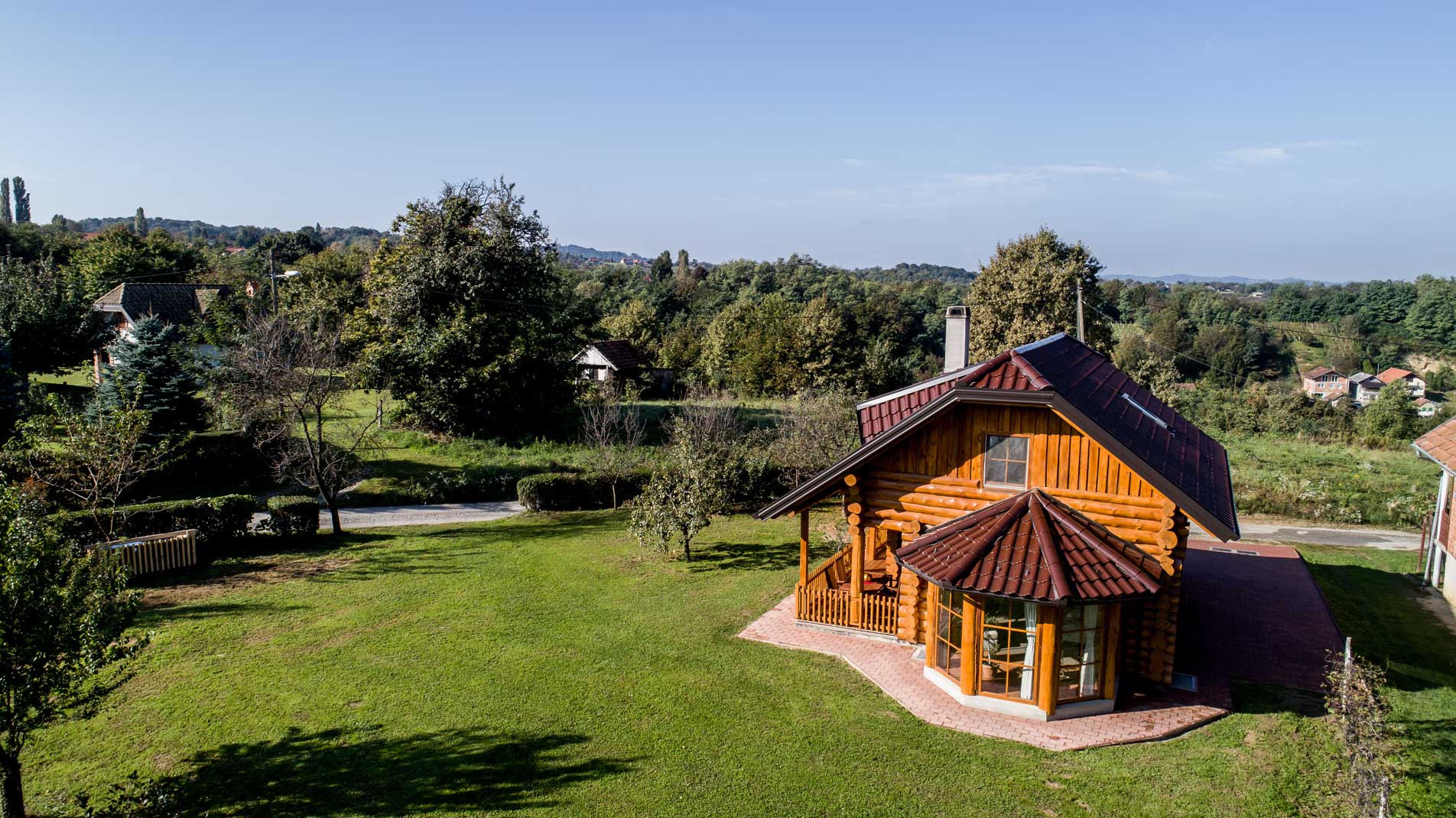
Hazelnut House holiday home, one option of where to stay when you visit Ludbreg © Varaždin Tourist Board
Why visit?
Truth be told, if you visit Ludbreg, you can see all of its sights in a day trip. And the town is perfect for just that. But, by doing so, you probably wouldn't get more than a tourist's glimpse of the place. Ludbreg is actually comprised of thirteen settlements that exist around the centre and it is within these quiet-looking hamlets and villages that most of the town's drive and ambition lie. This is where the people live. And, for a while, you can too. The whole town has a reputation for sustainable living and sustainable growth - pioneering waste management schemes, growing allotments granted to residents without gardens and technically advanced green power solutions. It is in these settlements that you'll find holiday homes designated to agro-tourism and ecotourism. Perfect for relaxing alongside only your nearest and dearest, they hold distinct, unique architecture, some have outdoor swimming pools and all are surrounded by clean, fresh air and nature. 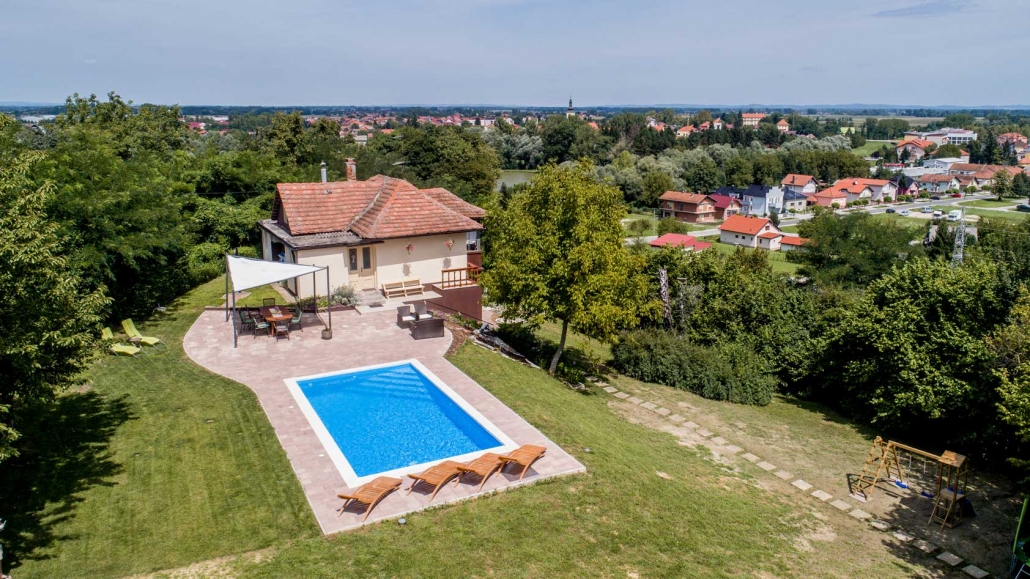
Villa Mila holiday home, another great place to stay when you visit Ludbreg © Varaždin Tourist Board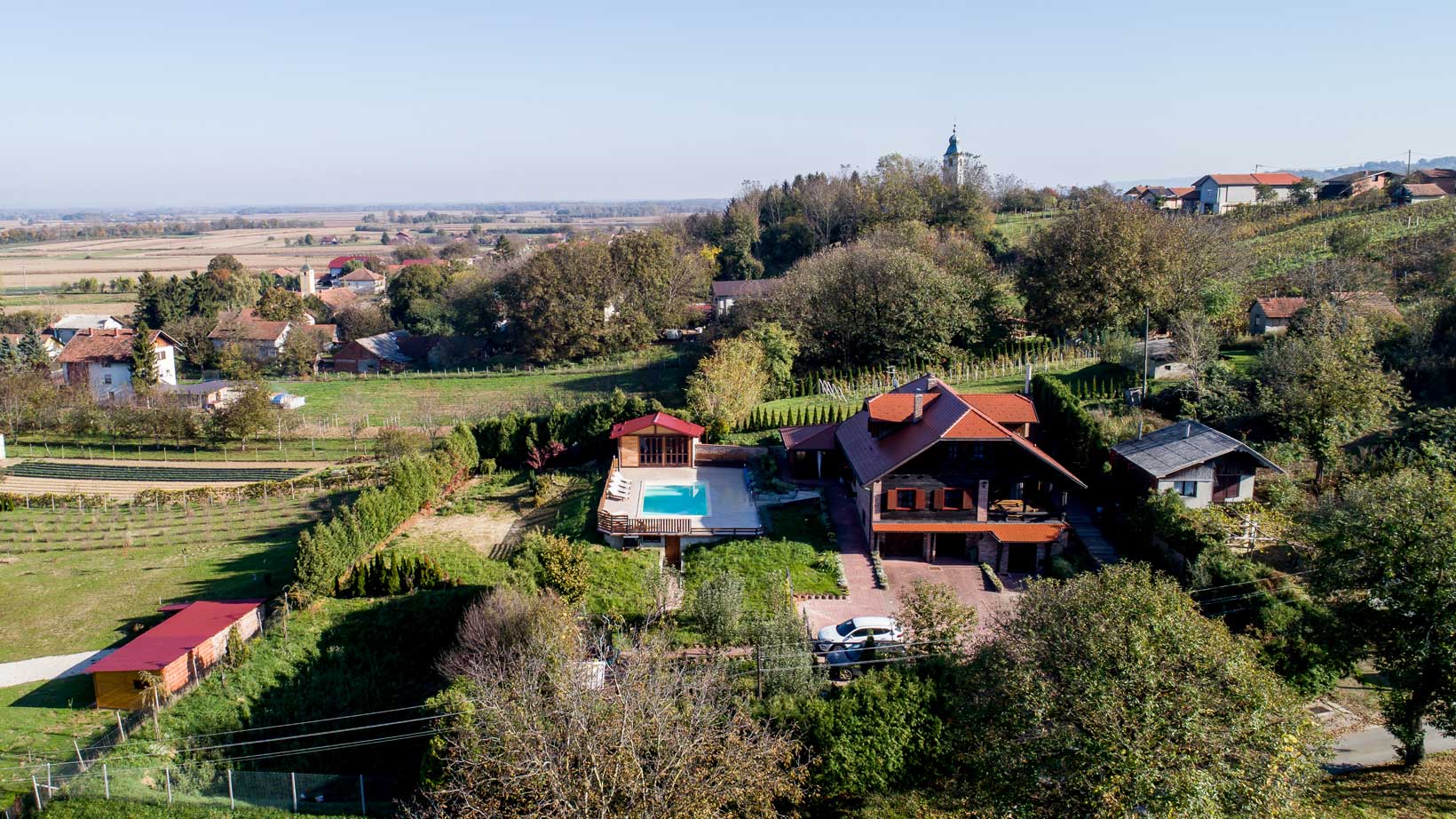
Rural House Gabrijela holiday home - you can get close up to nature and still keep the swimming pool when you visit Ludbreg © Varaždin Tourist Board
The bountiful nature surrounding Ludbreg is one which services the town's ancient industries, traditions and arts & crafts. Some of these you can see or join in with, the most famous being Ludbreg's wine roads. Take a tour of the area's vineyards, cellars and winemakers to sample great examples of continental wine. White wines are their forté and Graševina, Riesling, Pinot Blanc, Pinot Gris, Sauvignon, Chardonnay and Traminac are just some of the major league players available here, alongside rarer names like Moslavac and Manzoni. Muscat, Pinot Noir, Frankovka, Cabernet Sauvignon and Poštenjak can also be sampled.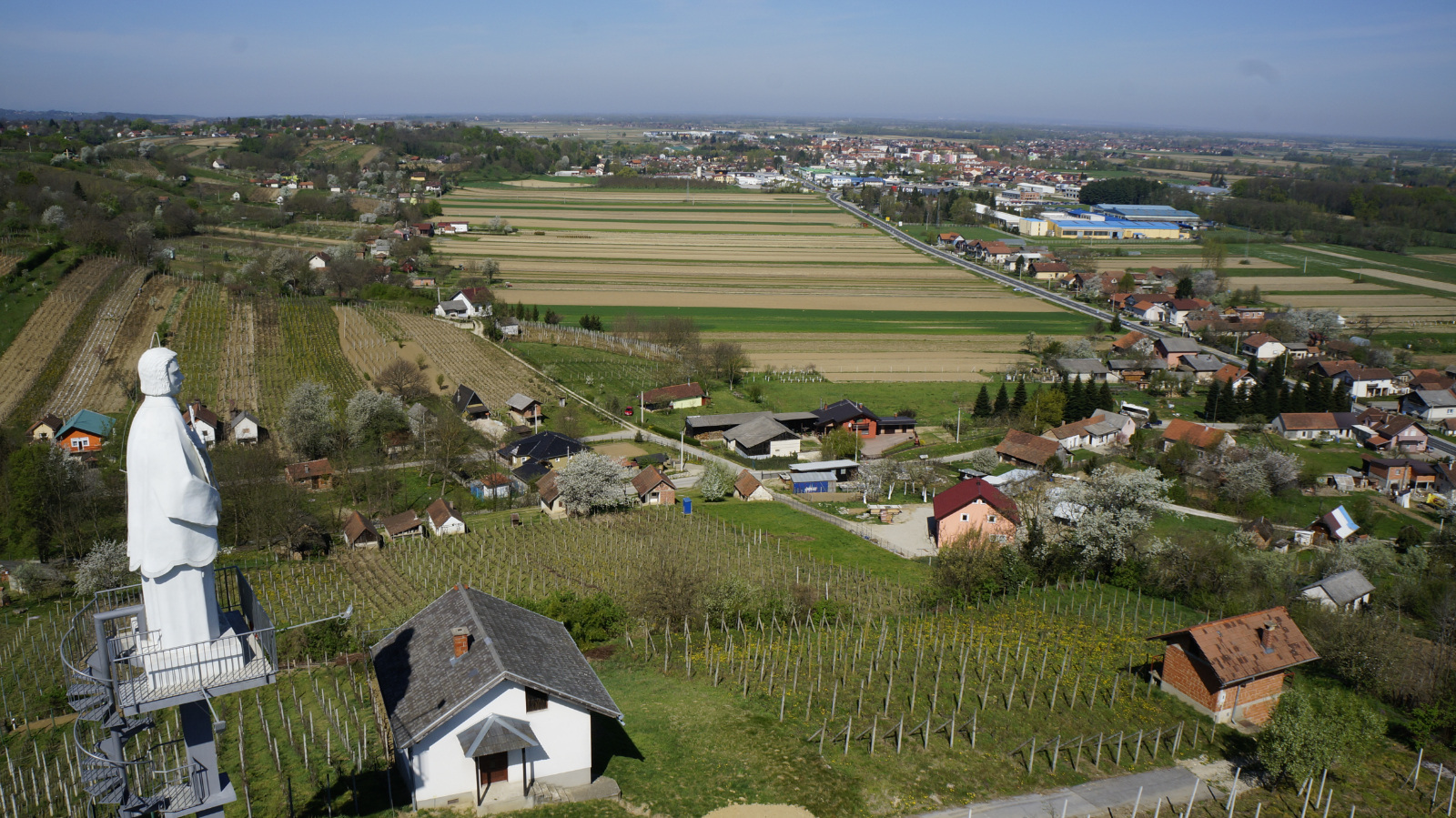
The wine roads surrounding the town are one of the best activities when you visit Ludbreg © Ludbreg Town
Alongside the sights, the other thing to catch when you visit Ludbreg is the events. In these regards, Ludbreg punches well above its welterweight. The town's event calendar is brimming with exciting or entertaining things to see and do. It wasn't so long ago that hundreds of participants and spectators from 33 countries descended on the town for the annual World Model Aircraft Championships. Ludbreg is used to happily hosting such hordes, its institutions beckoning thousands of visitors every year.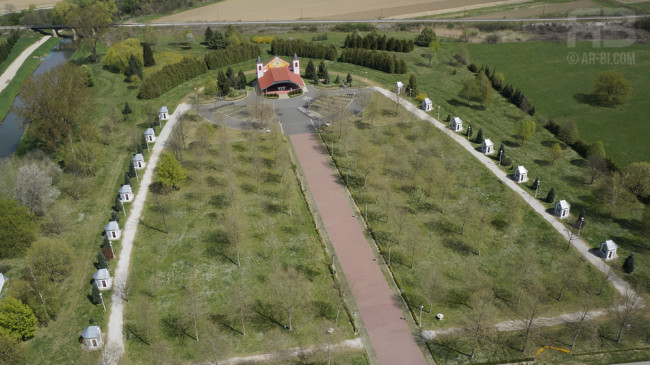
The peaceful approach to the pilgrimage site - one of the more famous reasons to visit Ludbreg © Ludbreg Tourist Board
The most famous of these institutions is the Catholic faith. Whether you believe the town to be named after a returning Crusader or an entranced winemaker, one history of Ludbreg holds a greater clarity due to its acknowledgement by the Vatican. Many people visit Ludbreg on devout pilgrimage because the Blood of Christ is said to exist here. When doubt entered into the mind of a local priest performing the Eucharist, it is said the vessel he held became filled with the actual Blood of Jesus Christ. Pope Julius II began investigating the claim thoroughly, so much so, that the miracle wasn't confirmed until the reign of his successor, Pope Leon X, in 1513. Pilgrims have visited Ludbreg ever since. The relic of the Precious Blood of Jesus is kept in Ludbreg's parish church of the Holy Trinity, although a special site for pilgrims was built on the edge of the town centre in 1992.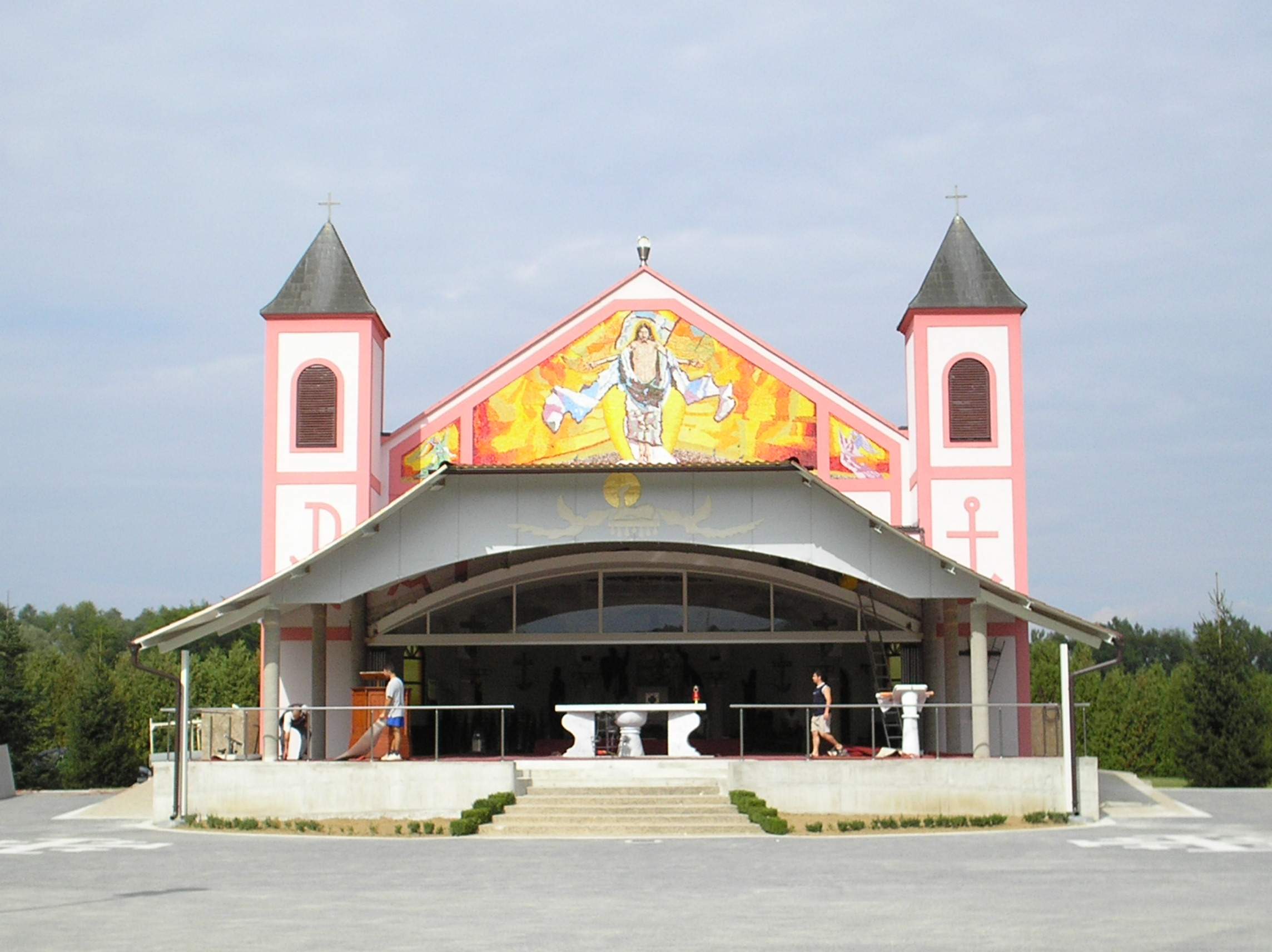
The pilgrimage site which the faithful flock to when they visit Ludbreg © Fraxinus
The most-famous architectural building in Ludbreg (and the prettiest) is the Baroque castle Batthyany. The castle dates from the reconstruction of the older medieval castle on the same site by Count Louis of Batthyany in the mid-18th century and today houses the workshop of the Croatian Restoration Institute. There, painstaking repair work is undertaken on historical items from all over Croatia which have been damaged by the years or in the war of the 1990s. Walking around the ultra-modern town centre of Ludbreg offers no clue that behind this castle's walls such careful preservation of the past is taking place.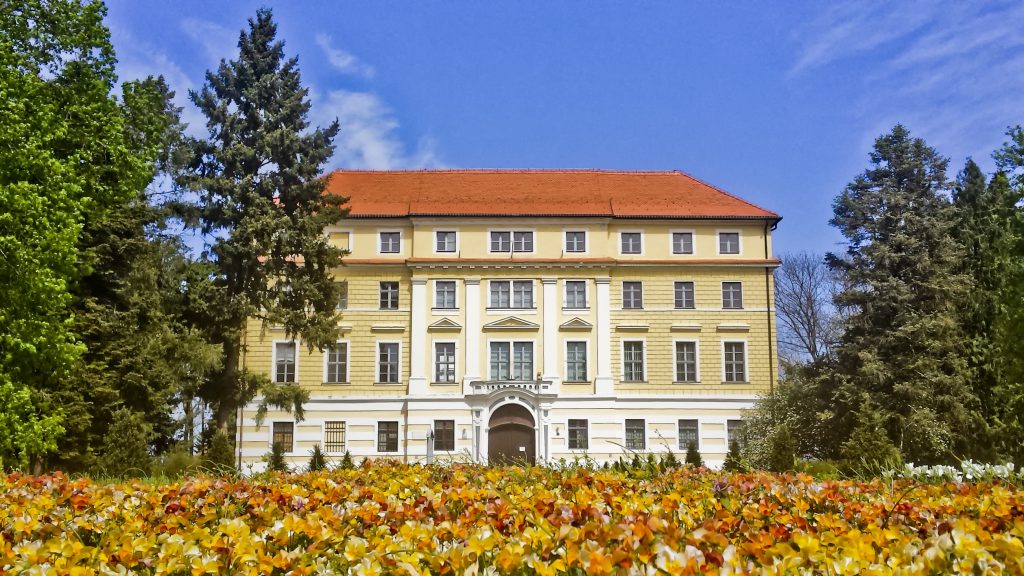
Batthyany castle in Ludbreg © Ludbreg Town
The other great institution of Ludbreg is also one which dedicates its life to preserving the past, but the history it protects belongs to the people, not the church. The cultural and artistic society KUD Anka Ošpuh, named after a female Partizan hero, has been operating in Ludbreg since 1976, although its roots are older. Many female-led charitable organisations operate in and around Ludbreg. That much of this work has existed in such hands for up to 150 years is simply remarkable, particularly within a broader Croatian society still viewed as patriarchal. Traditionally, while the young men of Ludbreg were drawn to more manly pursuits such as sports, bombastic brass instrument-playing and all-male choirs rooted in those of the church, the town's women were instead occupied with chores, charity work and the songs, dances and costumes of folklore. Folklore societies and their preservation of local, peasant traditions became incredibly popular all over Croatia after the Second World War. Early examples in the area of Ludbreg include Braća Kavurić from Martijanec (founded 1945) and that of Kutnjak (1947) with similar established in Sveti Đurđ, Sesvete Ludbreški, Dubovica and Vrbanovac. 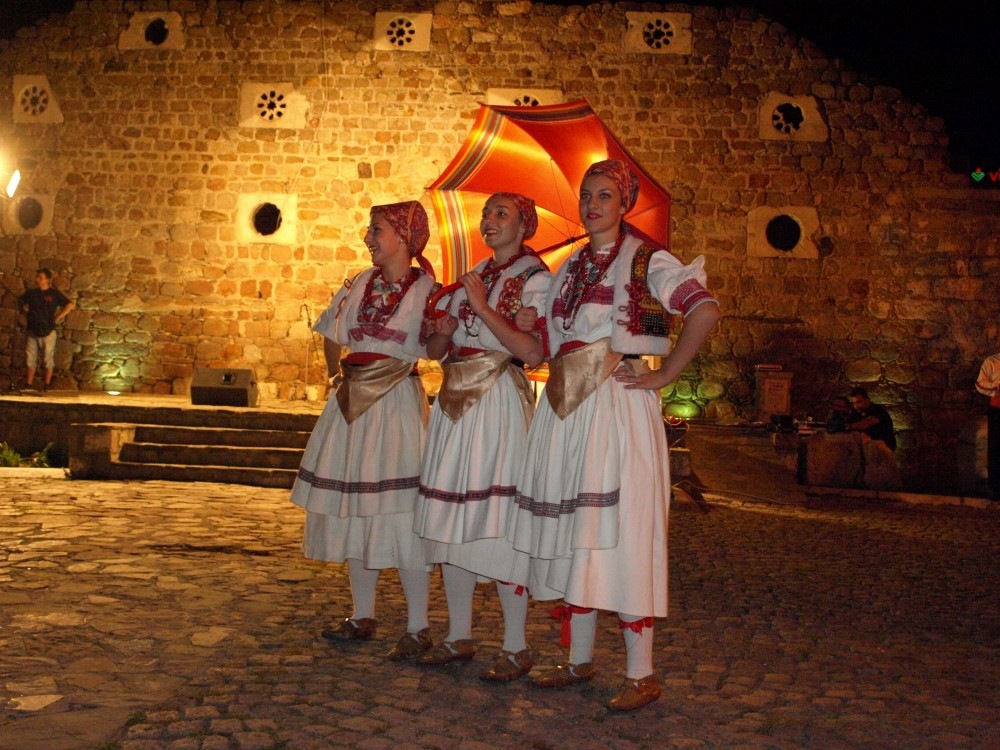
Contemporary members of folklore society Anka Ošpuh © Ludbreg Town
These village societies were mixed, but with the absence of any such society in central Ludbreg, it took 22 women to form the town's own. They made a great success of doing so. Although initially so poor with resources they had to practise in the basement of factories and local houses, by 1977 the society had grown to contain 79 members and was able to establish its own group of attached tamburica musicians and an all-female choir. As their reputation grew, the society absorbed many key contributors from similar groups in surrounding villages and their assets. To the 12 valuable Moslavina folk costumes with which they began, KUD Anka Ošpuh were able to add examples from Podravina, Slavonia, Dalmatia, Lika and even some worn by Croats in Vojvodina (present-day Serbia). Many of these costumes are still preserved or worn by society members to this day, kept alive, like the songs and dances of the region, by the society. These days, KUD Anka Ošpuh is one of the most highly regarded in Croatia and has performed all over the country, plus internationally at folk song and dance festivals. Its essential work is passed down to children and young people of the area in order that these traditions survive. Highly skilled and beautifully presented, they offer a glimpse of authentic and historic local culture. If you get the chance to see them, you simply must.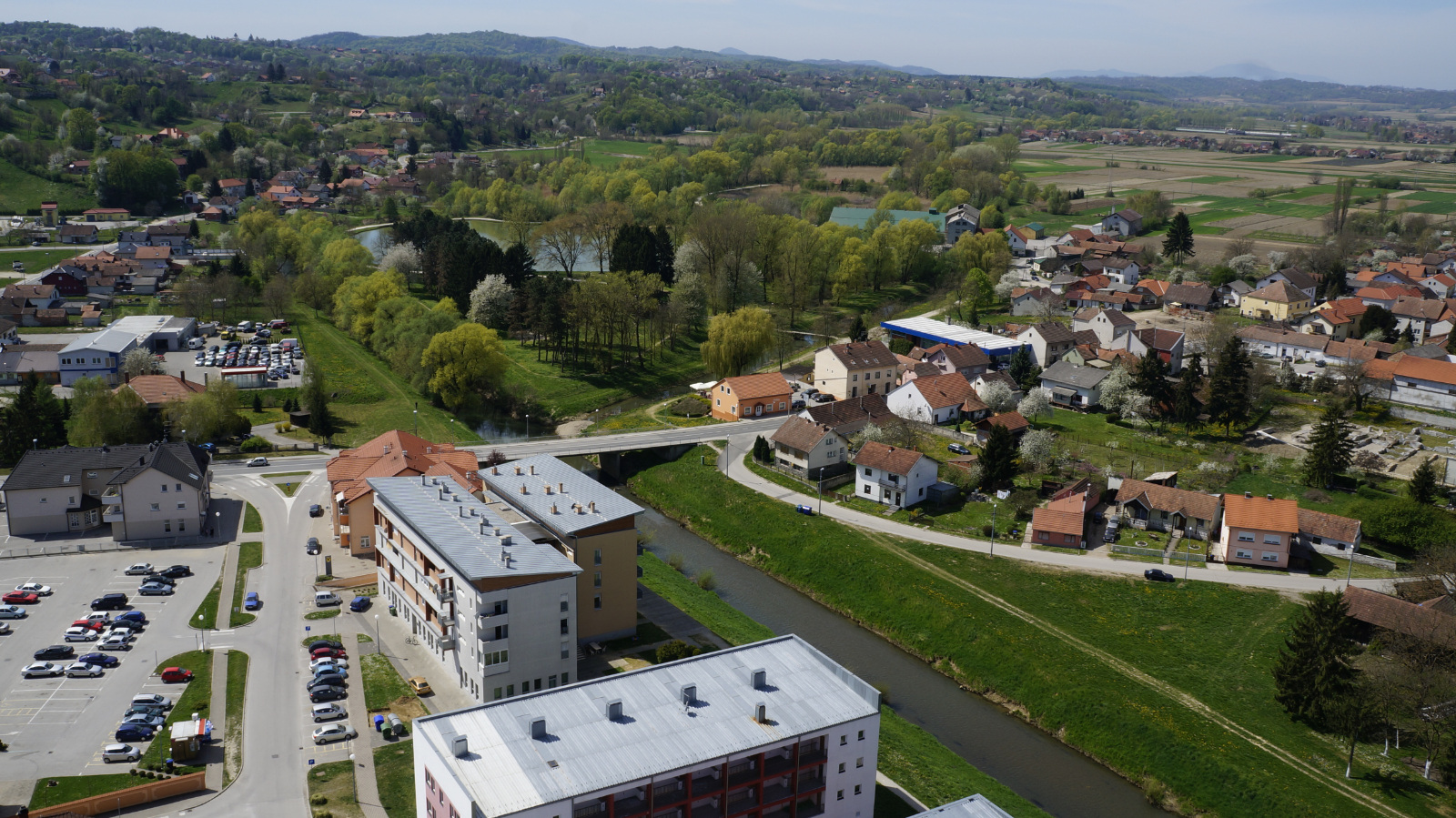
Ludbreg © Ludbreg Town
How to get to Ludbreg: The town lies approximately 100 kilometres by road from Zagreb, with bus or car being your options. Ludbreg has its own train station with trains running direct to Zagreb, Osijek and Varaždin.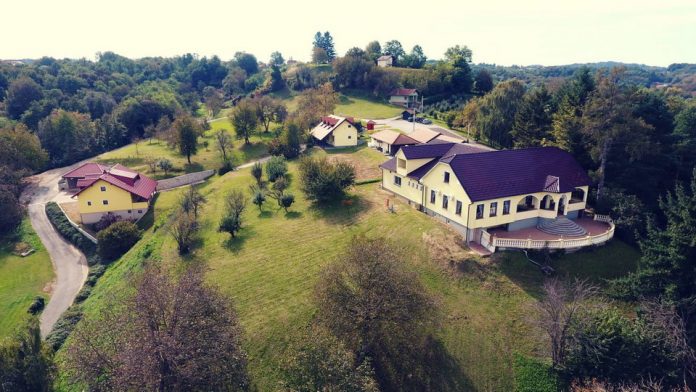
Črn-Bel restaurant © Črn-Bel restaurant / Luka Krušec (LuMedia)
Where to eat: Surrounded by vineyards and beautiful nature, the Črn-Bel restaurant is a brilliant spot for lunch or dinner. They do great grilled meats, superior pizzas from a wood-fired oven and sharing platters, with most ingredients sourced locally. Restoran Raj in the town centre is much more of an informal, family place, with pizzas for the kids and shared grills or deep-fried seafood for the parents.
Where to drink: Pivnica Mejaši is a great pub in the centre of town where you can refresh yourself. They have a lovely, covered outdoor terrace and a good pub-grub menu, including pizzas, which will satisfy for lunch or an informal evening meal.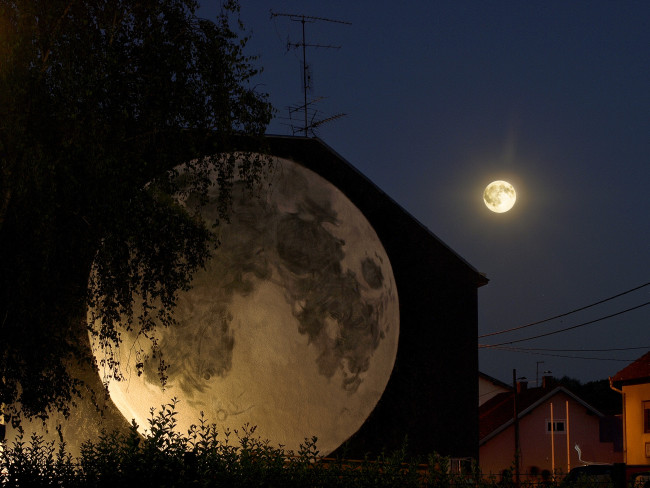
Ludbreg's first piece of street art is a mural of the moon © Ludbreg Tourist Board
What's new: Although the 'Centre of the World' is the star of the town's main square, you'll not miss several new additions to their menu of monuments. The latest is an artwork dedicated to young, local athlete Sara Kolak, a javelin player who earned a Gold medal for Croatia at the 2016 Olympics. She shares the square with a fountain, a photo opportunity spot and a remarkable solar-powered tree where you can charge your phones and other devices for free. For the cool cats, the town has a brilliant mural of the moon on one building facade – it's Ludbreg's first street art piece. The town will host a conference on cycling tourism from 16 – 18 September 2020.
Ludbreg's town centre © Ludbreg Town
What not to miss: For a small place, the list is huge. Don't miss the parish church of the Holy Trinity, its interior is delightful. You must visit the castle too and take the pilgrim's walk up to the modern ecclesiastical point of worship. LUMEN, a Ludbreg youth organisation, hold great music and theatre events. Centre of the World Day is April 1 and everyone joins in during the town's big day. The fountain on the central square flows with wine for the occasion. The town's carnival sees joyful residents march the chilly streets in costume. It's 164 years old and takes place on Shrove Tuesday. Ludbreg's Advent festivities grow year upon year. Also in winter, at the end of January, the town's winemakers present their fresh batches at the Young Wine Days.
Ludbreg's central square. During its three-day International Flower Festival, the town explodes with even more natural colour © Ludbreg Tourist Board
The town's three-day International Flower Festival is the second biggest in Croatia and is an explosion of natural colour. You can visit it at the end of April / beginning of May. The Ludbreg Bike Tour is a 15 kilometre run around the town, with a great afterparty at the picturesque Youth Island (main picture). Two more great parties are Idemo Otok in June and Crazy Island in August. Strange to imagine such a small place hosting two electronic music festivals of such far-reaching repute, but it does. Young dance music enthusiasts from all over Croatia travel here to attend them. Again, they take place on Youth Island. Although pilgrims visit throughout the year, many reserve the journey for the seven days surrounding Holy Sunday. KUD Anka Ošpuh holds folklore events throughout the year including a memorial performance for former president Mirjana Bošnjak, a springtime celebration, Ludance (which focusses specifically on local folklore), a wintertime celebration, Christmas show and, pick of the bunch, Folklore Meetings in the Centre of the World, during which they're joined by outside folklore societies. KUD Anka Ošpuh's great tamburica orchestra also play many dates independently, as do the once-attached but now independent, all-female Podravina choir.
What to buy: Ludbreg has had a beekeeping society for over 70 years and local beekeepers know their stuff. Ludbreg honey is a great gift to take home, as are any of the bottles of fine wine produced around the town.
Ludbreg's town centre © Ludbreg Town
On these links you can read about the other destinations in our The Croatian Road Less Travelled series:
Osijek - the capital of Slavonia, on the banks of the Drava
Donji Miholjac - a hidden gem in the heart of the Pannonian basin
For the latest news from Ludbreg, check out the dedicated TCN section.
For the latest travel info, bookmark our main travel info article, which is updated daily.
Read the Croatian Travel Update in your language - now available in 24 languages
How a Ludbreg Conference Saved Syrian Cultural Art and Treasures
June 20, 2020 - Did you know that one of Europe's major restoration centres is in Varazdin County? Or that it was at a Ludbreg conference that Croatian war experiences helped to preserve much Syrian art and cultural treasures in the recent conflict?
One of the things I love about writing about Croatia is that there is always a story untold around the corner. This country is FASCINATING, and to give you a hint of how much fun and discovery you can enjoy here, here are 30 great discoveries I made in 2019 alone.
And if there is one place in Croatia which continues to surprise with every visit, it is the town of Ludbreg in northern Croatia. It is known to many here as the 'Centre of the World', but very few people even in Croatia know that it is home to the only certified miracle in all Croatia. You can read about the Ludbreg miracle here.
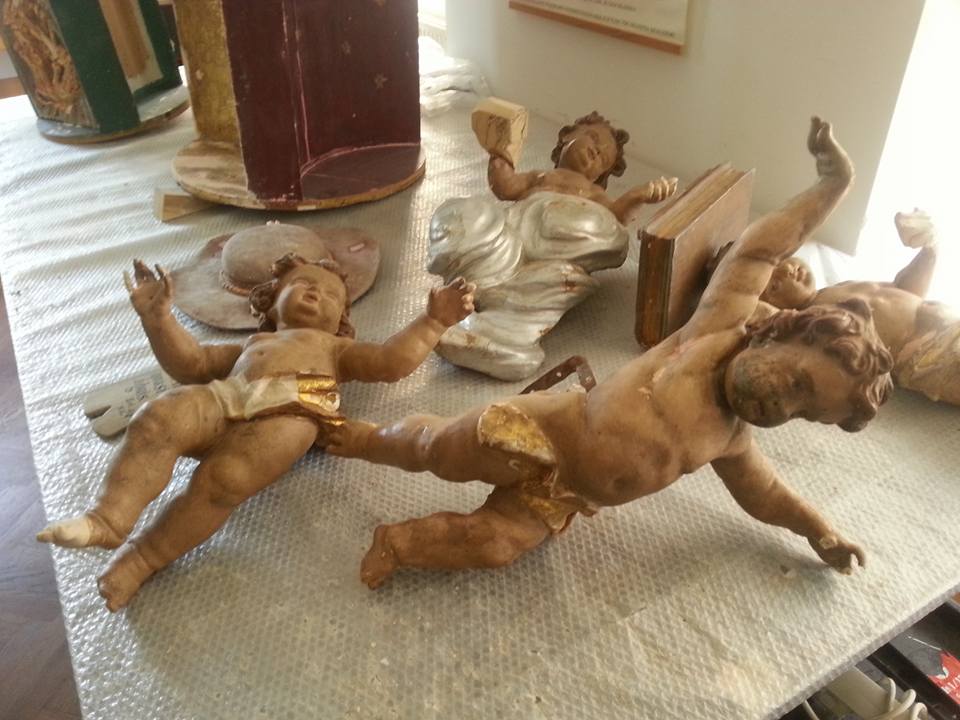
There are plenty of other unusual things to find in Ludbreg as well, as I noted after my first visit in 2016 in Ludbreg, the Most Fascinating, Unusual Little Town in Croatia?
Among them was the Ludbreg Restoration Centre, one of three major centres of restoration of Croatian art and cultural treasures. Tucked away on the upper floors of the impressive Batthyany Palace in the centre of town. For there you will find a team of some of the most skilled and dedicated professionals painstakingly restoring the many cultural treasures partially destroyed during the Homeland War and other events.
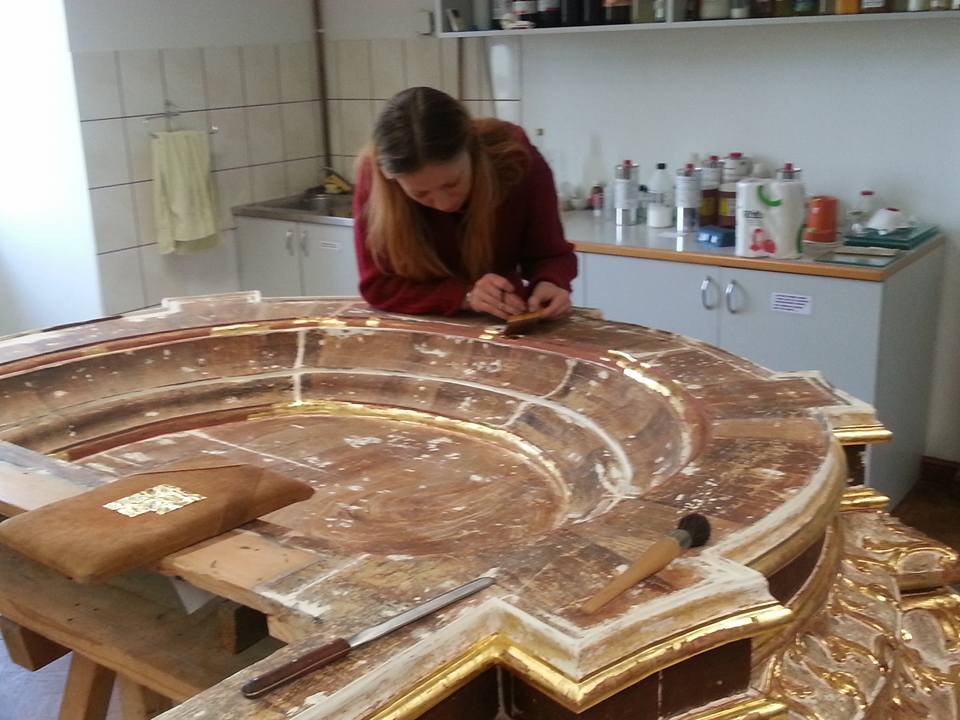
I visited the centre again recently, as part of our filming for the One Minute Ludbreg video series, which we will be starting shortly, only to be stunned all over again.
Not only was the centre doing outstanding work, but it was also winning international awards for its excellence. Take a look at the video below, for example, of the incredible restoration job on the equally incredible St Martin's Church in Stari Brod, near Sisak.
The careful restoration won an award at the 2017 European Heritage Europa Nostra Awards - you can read more about that here, as well as enjoy this fabulous little church in the video below.
And, as we went around filming for One Minute Ludbreg, I learned SO much more on this, my second visit. How the chief restorer of the Sistine Chapel is a regular visitor to Ludbreg, and how a number of international restoration conferences are held in this miracle town.
During one such Ludbreg conference several years ago, at the height of the fighting in Syria, the topic on the table was how to protect Syrian cultural treasures during such a destructive conflict.
The Croatian experience of the Homeland War was that if a building was an obvious cultural treasure, it tended to be targeted, and so the advice to the Syrians was to remove any signs of cultural status from the buildings they wanted to preserve. As a result, many were spared which otherwise might have been destroyed.
I could have spent hours in there, just watching experts and masters in their crafts quietly going about their daily business, with a passion that was enviable. Experts such as Dunja, for example, who was delicately applying 24-carat gold leaf to historic wooden surfaces.
One Minute Ludbreg will start next month.
For more details on the incredible work of the Croatian Conservation Institute, visit the official website.
For the latest news from Ludbreg, follow the dedicated TCN section.
One Minute Ludbreg, a Local Tourist Board Initiative for Virtual Croatia
May 24, 2020 - The world has changed, and so has destination promotion. Meet One Minute Ludbreg, a low-budget video project to make a destination's attractions virtually available in one place.
It would be wrong to assume that all local tourist boards are the same in Croatia, and some are working very hard to promote their destinations. You can get an idea of who in the coming weeks from our new Virtual Croatia page, which is the result of an offer of a free promotional article putting all the destination's virtual tools in one place for the first time. So far we have done Zagreb, Hvar, Sinj, Klis, Trogir, Stari Grad, Opatija, Omis, Brela and Rogoznica. You can see these articles here. Time is my enemy at the moment, but I now have about another 25 from the submissions I have received. Next on the list are Lumbarda, Vukovar, Inland Dalmatia and the island of Brac, which will be one article, with all 8 Brac tourist boards contributing.
And there is another project from a local tourist board which predates corona that I want to tell you about. It is called One Minute Ludbreg.
Late last year, the town of Ludbreg invited me for a meeting to see how I could help the town with its promotion and tourism strategy. I had a productive meeting with the Mayor of Ludbreg Dubravko Bilic and Ludbreg Tourist Board director Andrea Horvat and agreed to work with on a number of strategies to try and boost tourism, as well as raise the profile of the town's successful economic story.
I have always liked Ludbreg, since my first visit with Elizabeta Dolenec, the then Varazdin County Tourist Board director back in 2016. You can read those initial impressions in Ludbreg, the Most Fascinating, Unusual Little Town in Croatia?
Andrea and I had a good chat about the destination and the possibilities, and we have been quietly working on a number of initiatives, some of which were interrupted by corona, of course. These include a project with Polish tour agencies to bring pilgrims en route to Medjugorje to Ludbreg. Unlike Medjugorje, Ludbreg has a Vatican-certified miracle which you can actually visit. In fact, it is the only certified miracle in Croatia that you can visit, which makes Ludbreg officially Croatia's miracle capital. I was shocked how few locals in Zagreb even knew this.
Another concept we decided to work on was One Minute Ludbreg. Ludbreg actually has lots to see, but many of these attractions take 5-10 minutes each. It is actually a very fun family destination just an hour out of Zagreb, with several good restaurants and three hotels. And if you are religious, why not come for Sunday Mass in a church with a certified miracle on view?
How to capture all the different attractions to present them to future guests? We came up with the concept of One Minute Ludbreg. A video introduction to each attraction, which would be available on the Ludbreg YouTube channel.
I have very little experience with presenting on video, and I have a lot to learn. We made a start, to see how it would go, more for Instagram than YouTube (hence the portrait v landscape) with our first One Minute Ludbreg video about the Sara Kolak javelin monument on the main square next to the Centre of the World. The video was shot and edited by Gustavo Vilera.
Corona came, and lockdown on Hvar meant that this aspect of One Minute Ludbreg would have to be put on hold.
But Hvar did give us the chance to get more experience, and I have been having lots of fun putting various parts of this gorgeous island online, with my local knowledge and anecdotes to give extra value.
We now have a concept finally, and I was delighted to be back in Ludbreg this week to resume filming.
I will be back again on Thursday with TCN intern Janja to spend the day filming with the mayor, the winemakers and other attractions, with the first video in the series due in a couple of weeks.
One Minute Ludbreg is a simple, low-cost concept that can be done by anyone. It gives potential tourists just a little bit more to help them get to know the destination and decide if they want to visit.
If you are interested in working with us on the One Minute Ludbreg concept in your destination (as a tourist board, hotel group or private individual), please contact us on This email address is being protected from spambots. You need JavaScript enabled to view it. subject 1 Min Ludbreg.
You can follow the One Minute Ludbreg series when it goes live on our Virtual Croatia section.
For the latest travel info, bookmark our main travel info article, which is updated daily.
Church Building Promise: How Croatian Parliament Battled 1739 Plague
March 27, 2020 - COVID-19 is not the first unwelcome infectious enemy to come to Croatia, and Vili Beros was not available in yesteryear, so how did the Croatian Parliament battle the 1739 plague? With a promise which was fulfilled just 26 years ago, in 1994.
One of the most interesting stories I have come across in continental Croatia is from the town of Lubreg, about one hour north of Zagreb close to the Hungarian border.
Ludbreg is known in Croatia mostly for its claim to be the centre of the world, but as I discovered on my first visit a few years ago, it actually has another more intriguing claim to fame - it is home to the only certified miracle in Catholic, complete with Papal Bull which you can see in the small museum behind the lovely chapel where the Eucharistic Miracle of Ludbreg took place in 1411.
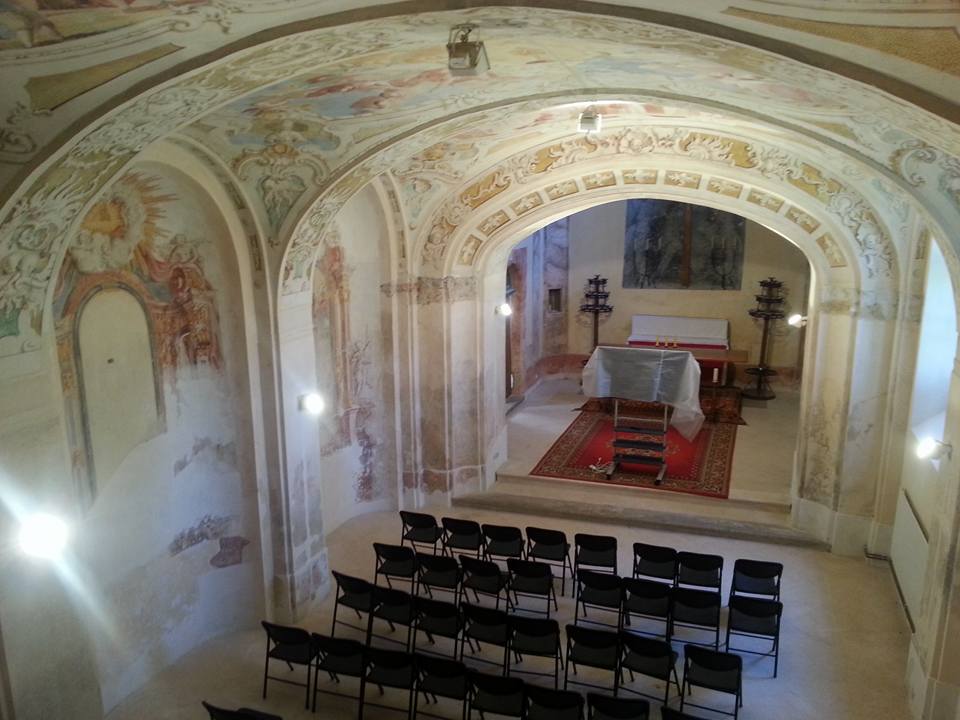
I have written about the miracle before in detail, so no need to repeat here (you will find more on this link, and on the video below, which is in Croatian only),
But the miracle is only part of the story, and it featured again during the 1739 plague which came to Croatia, extending as far as Brac. As I wasn't here at the time, I checked with Wikipedia on the 1739 plague:
The Great Plague of 1738 was an outbreak of the bubonic plague between 1738–1740 that affected areas in the modern nations of Romania, Hungary, Ukraine, Serbia, Croatia, and Austria. Although no exact figure is available, the epidemic likely killed over 50,000 people.
In February 1738 the plague hit the Banat region, having been spread there by the Imperial Army.
According to the 1740 Hungarian Diet, the Great Plague claimed 36,000 lives.
Southeastern Transylvania may have been the hardest area hit. Over the following eight years, the plague killed a sixth of the population of Timişoara. Timişoara's Monument of the Holy Trinity in Piaţa Unirii is dedicated to the plague's victims. The plague would return to hit the city again in 1762–1763.
Other cities in the region were also stricken. Between October 1737 and April 1738, 111 deaths were reported in Zărneşti, and 70 in Codlea.[2] More than 10% of the population of Cluj-Napoca was reported to have been killed by the pandemic.
The disease's spread extended to the Adriatic. It made its way to the island of Brač in modern-day Croatia.
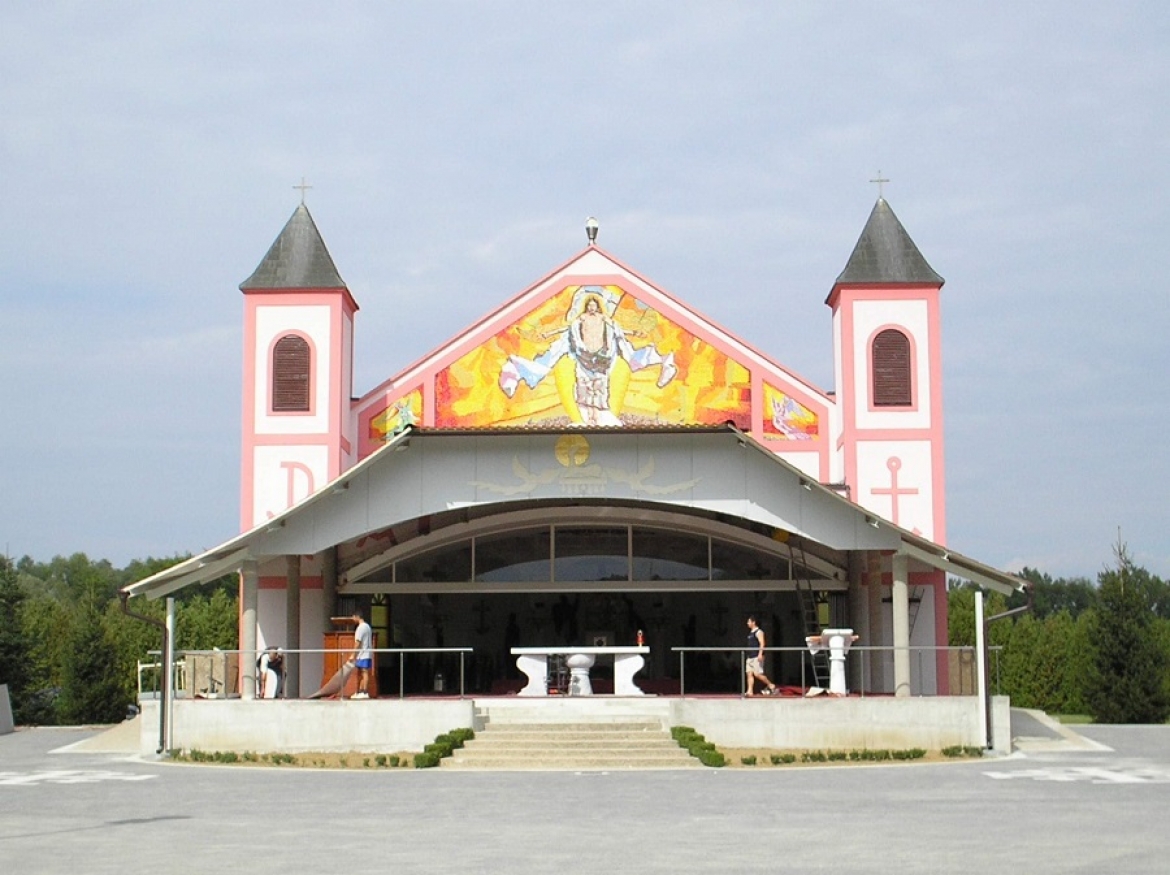
One of the actions undertaken by the Croatian Parliament in the capital of the time, Varazdin, was an undertaking to build a church of thanks in the miracle town of Ludbreg if the plague was stopped, promise which was actually fulfilled only 26 years ago, in 1994, during the Homeland War: According to The Real Presence:
In the 18th century northern Croatia was ravaged by the plague. The people turned to God to call upon His help, and the Croatian Parliament did the same. During the session held on December 15, 1739 in the city of Varazdin, they vowed to build a chapel at Ludbreg in honor of the miracle if the plague ended. The plague was averted, but the promise vow was only fulfilled in 1994, when democracy was restored in Croatia. In 2005 in the votive chapel, the artist Marijan Jakubin painted a large fresco of the Last Supper in which Croatian saints and blesseds were drawn in place of the Apostles. St. John was replaced with Blessed Ivan Merz, who was included among the 18 most important Eucharistic saints in the Church’s history during the Synod of Bishops held in Rome in 2005. In the painting, Christ is holding in His hand a monstrance containing the relic of the Eucharistic miracle.
The church and surrounding park welcomes 100,000 pilgrims in the first week of September each year - see the video above.
And below, in Latin and Croatian, the official documents to fight the 1739 plague.
To follow the latest in the modern-day fight against coronavirus, follow the dedicated TCN section.
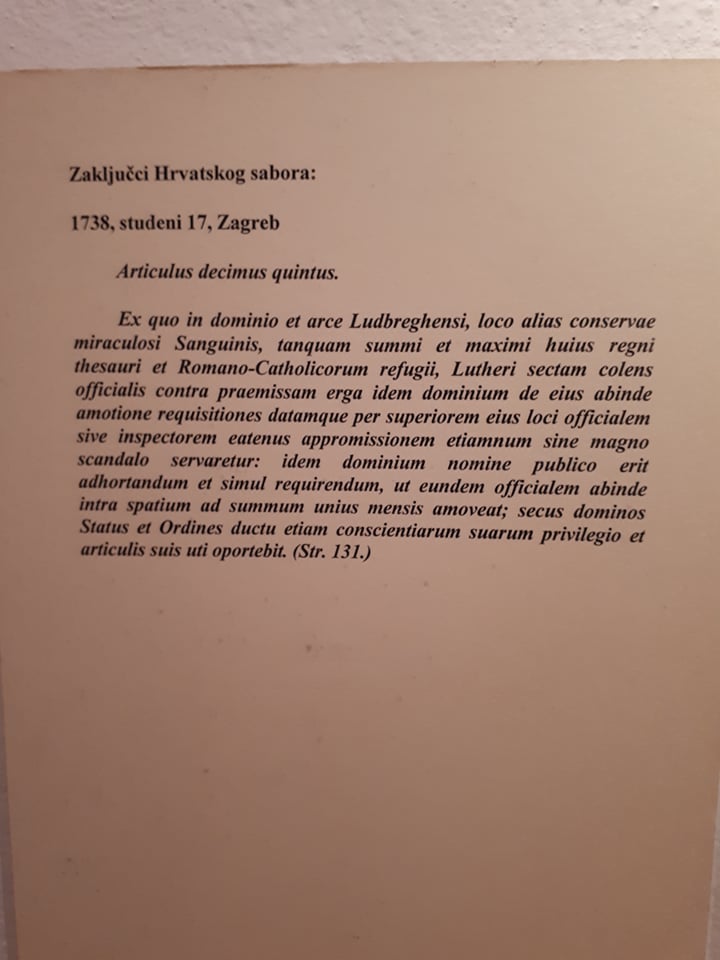
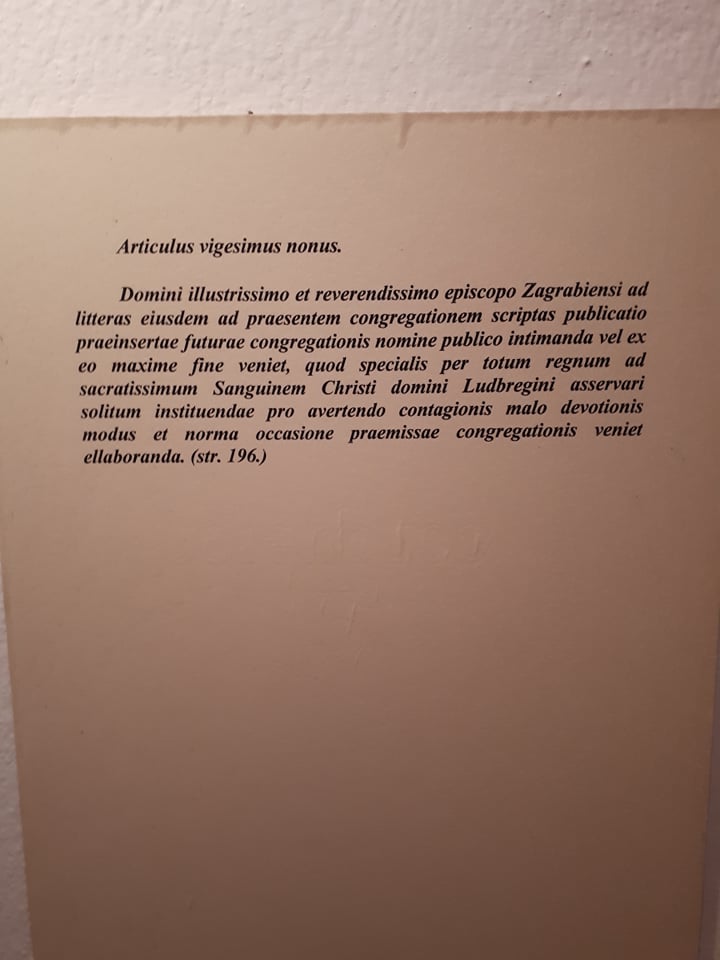
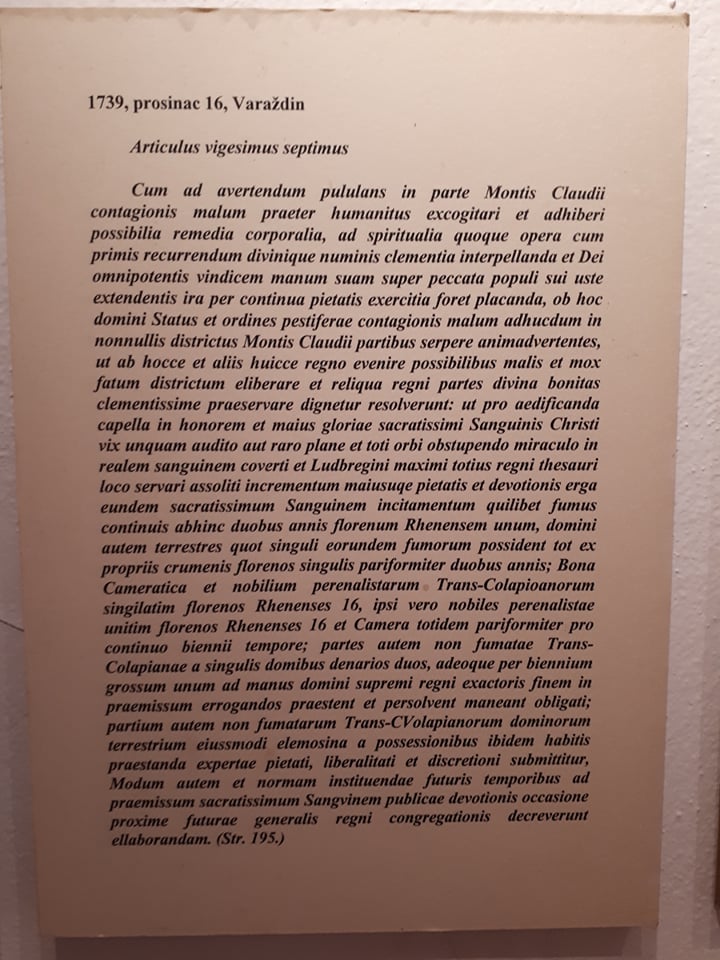
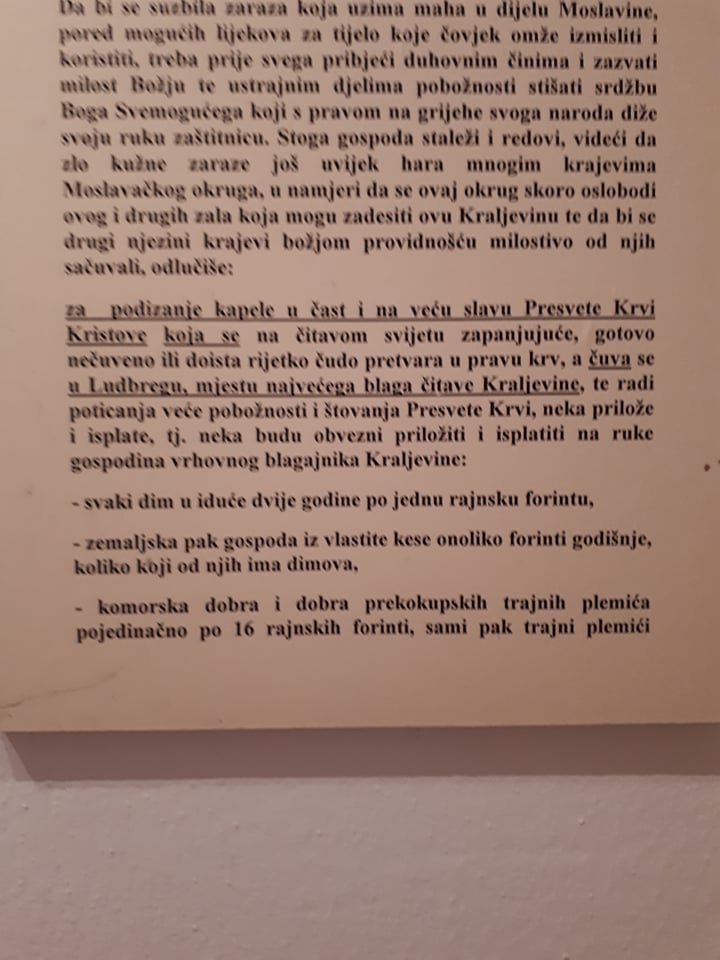
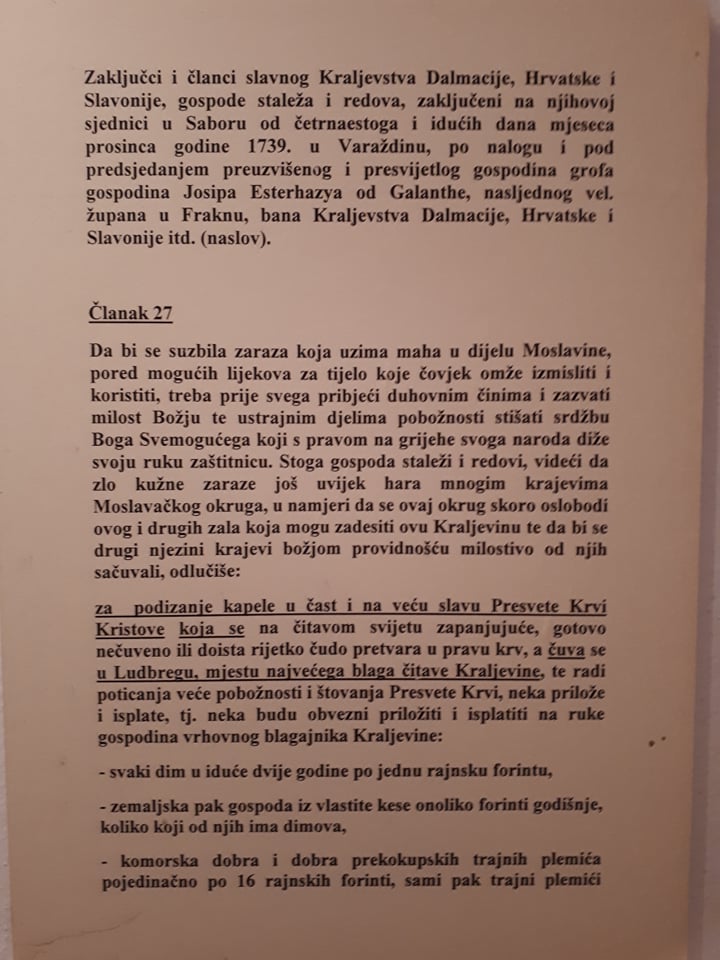

Inviting Zagreb Catholics to Mass, Day Trip to Croatia's Only Miracle Town
February 27, 2020 - I am amazed at how few people in Croatia know about its only Vatican-authenticated miracle. An invitation to Zagreb Catholics to discover it during Sunday Mass.
There are many things that amaze - and continue to amaze - me about living in Croatia. Among them are the fabulous discoveries I am making here on a monthly basis, many of which are known about by only a few people. I summarised an overview of 2019 fun in an end of year post - Why I Live in Croatia: 30 Incredible Discoveries in 2019 Alone.
Among those discoveries was finding out that Croatia only has one Vatican-certified miracle, and one which you can actually visit. In contrast to Medjugorje, where there is actually nothing to see and which has not been endorsed by the Vatican, and which attracts more than a million tourists every year, Croatia has its very own authenticated miracle which you can actually see, along with the Papal Bull that was issued by the Vatican.
A one-hour drive from Zagreb.
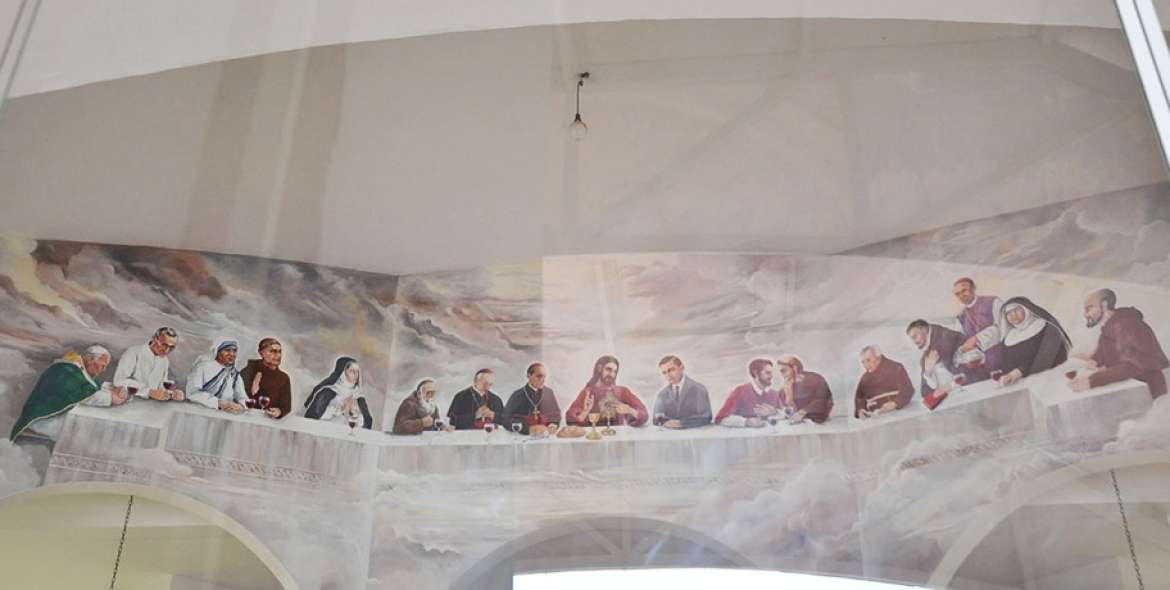
The Eucharistic Miracle of Ludbreg is a fascinating story of three churches, which I have written about before (full story here), and it comes with some rather unusual additional touches, such as this very rare fresco of the Last Supper, with the Eucharistic Miracle featured, and the disciples replaced by prominent Croatian saints and religious figures - find out who they are here.
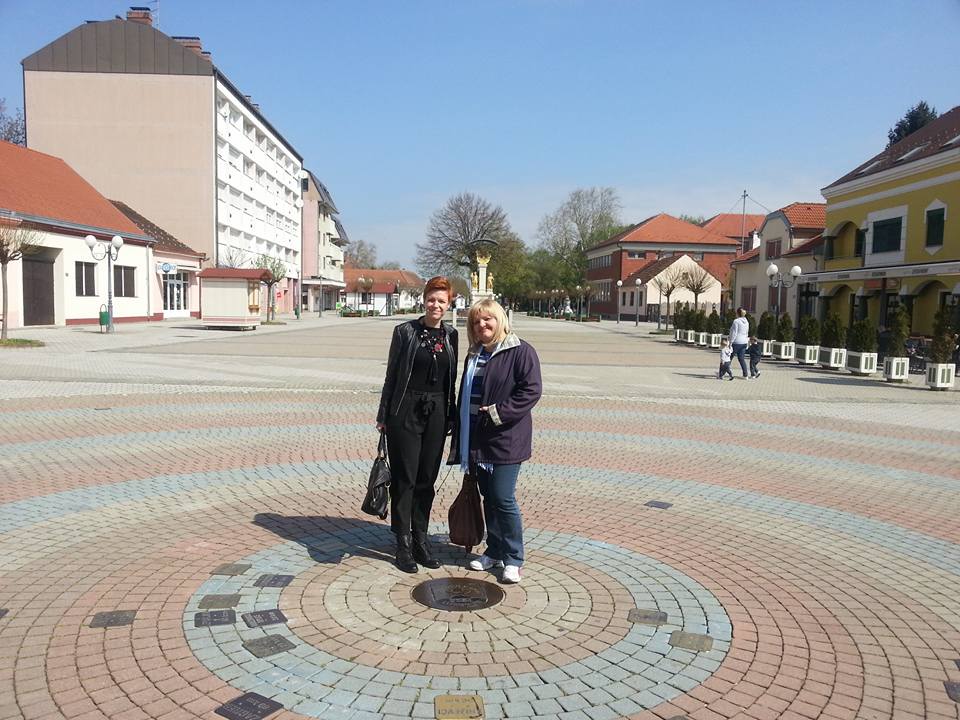
Ludbreg is best known, of course, as being 'the centre of the world', and if I ask locals what they know about Ludbreg, this is usually all that they come up with. And if I ask people here if they know which is the only certified miracle in Croatia that you can visit, only one person has so come up with the right answer.
In fact, it has become rather a fun hobby to tell Catholic friends the story of the three churches and then guess the location. Invariably, they get sucked in by the story, but still have no idea where it is.
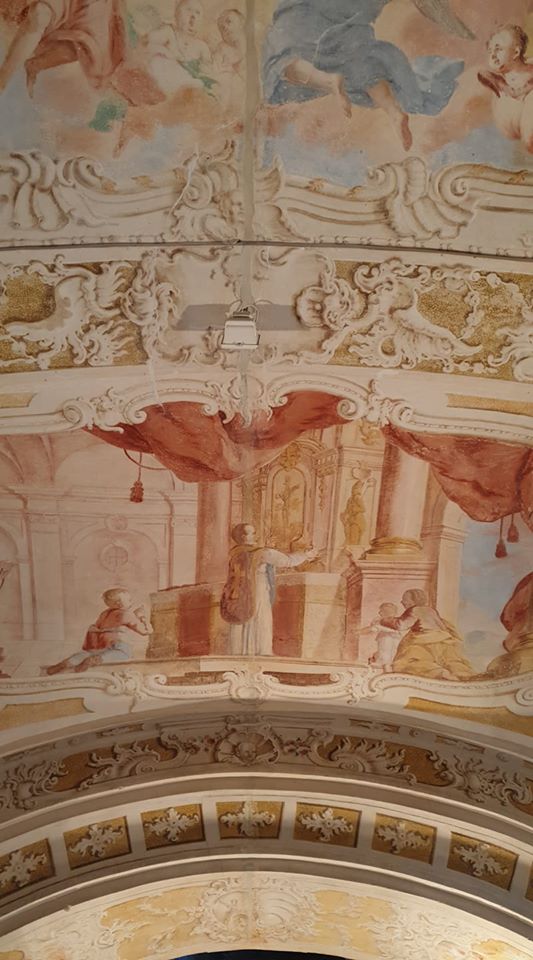
You can read the whole story in the link above, but it is beautifully told in the frescoes on the original chapel where the miracle took place.
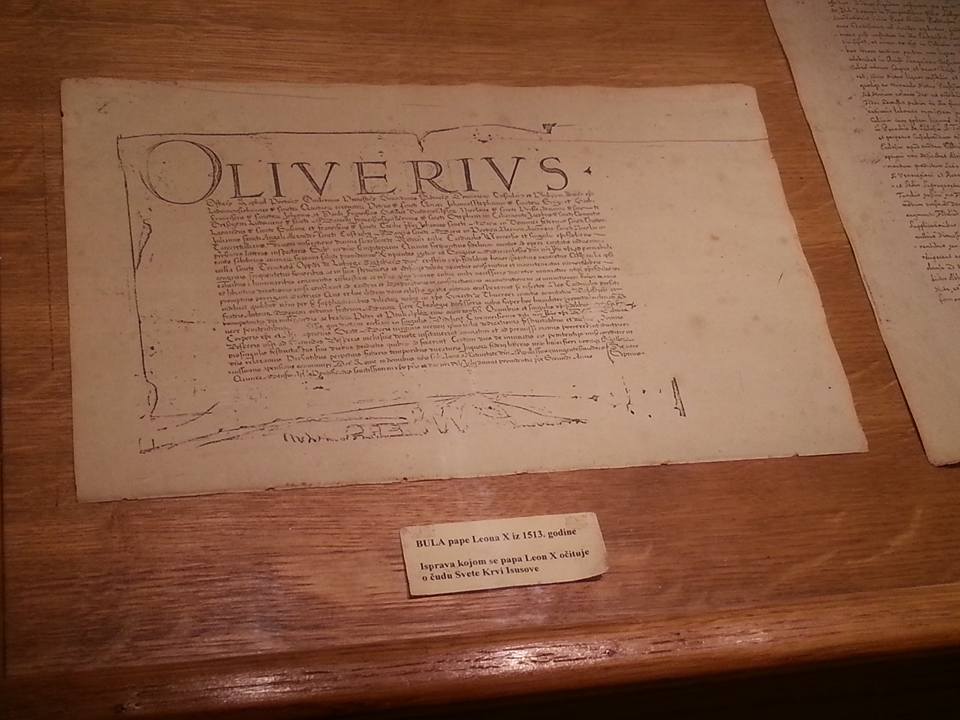
Having enjoyed the chapel, one of the many fascinating exhibits is the Papal Bull issued by Pope Leo X back in 1513, which confirmed the authenticity of the Eucharistic Miracle of Ludbreg.
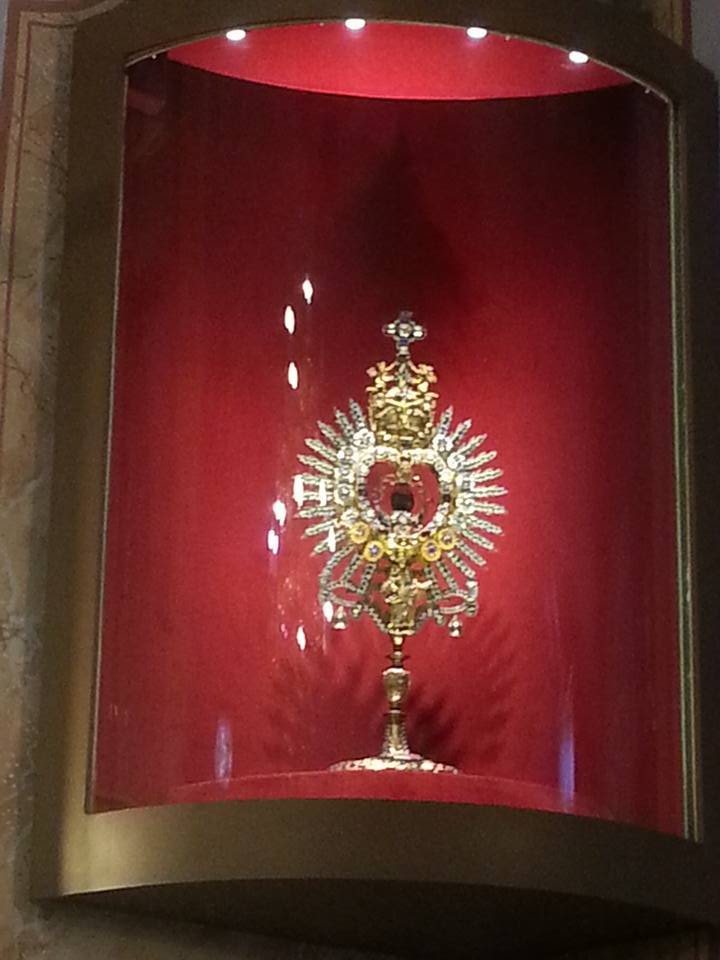
The chalice holding the blood is not in the chapel where the miracle occurred, but in the main church just a few metres from the centre of the world.
With so many Zagreb Catholics going to Mass each Sunday, why not do something a little different for the Sunday worship - Holy Mass by the centre of the world in the presence of the only certified miracle in Croatia.
The very helpful Ludbreg Tourist Board provided me with information about Mass times on Sundays - 07:30, 09:30 and 11:00.
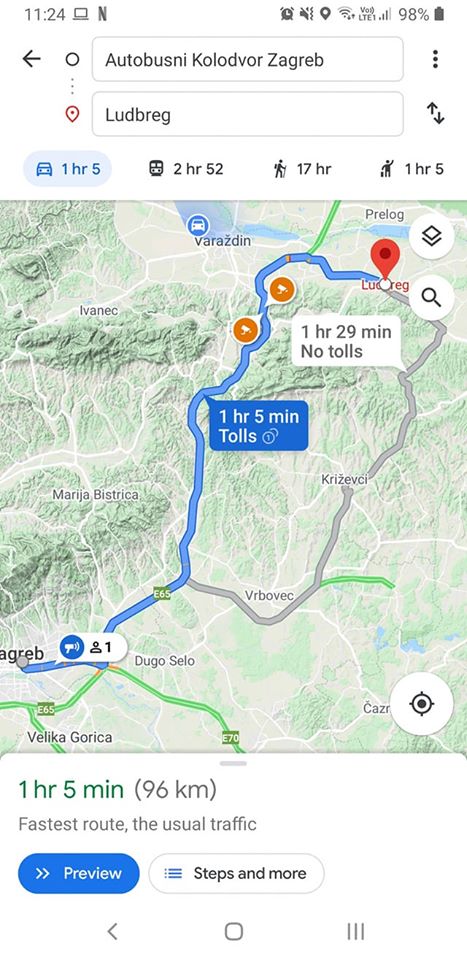
Ludbreg is just an hour by car from Zagreb, so not too far for a little day trip to discover a little of Croatia's heritage as well as attending Mass.
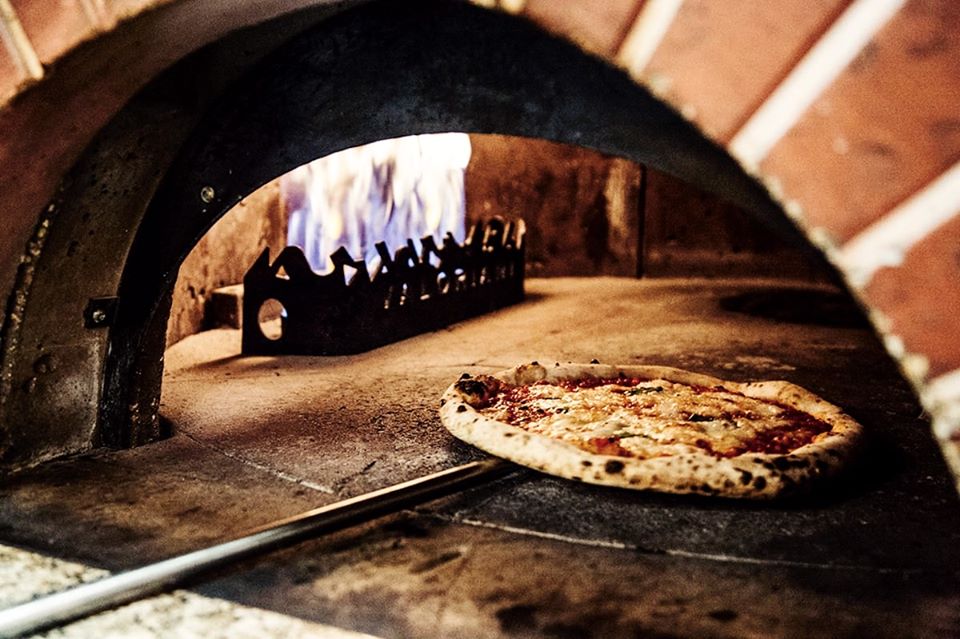
And while many complain that things are shit on the Adriatic coast during winter, things are open all year in Ludbreg. In addition to the three hotels working all year, there are five restaurant choices for Sunday lunch, according to the tourist board:
Pivnica Mejasi (on the main square, next to hotel Amalia), Hotel Raj (across from the shrine), pizzeria "Shark" next to Hotel Raj), restaurant Crn-Bel (in the hills not far from the center of town) and Restaurant Arabela (outside the town on the main road to Koprivnica, maybe 10 min drive away from the center).
One thing to note for those interested in doing the day trip is that the frescoed chapel (which is REALLY impressive) is not open to the public, but can be opened by appointment. The Ludbreg Tourist Board would be happy to organise that after Sunday Mass for anyone interested, but only by making an appointment by email no later than the previous Wednesday. You can contact the Ludbreg Tourist Board via their website, which is in English and Croatian.
For the latest news from Ludbreg, follow the dedicated TCN section.
Ludbreg's International Young Wine Exhibition Held
The town of Ludbreg hosted yet another edition of the International Young Wine Exhibition Vincekovo 2020 last Friday, and the international jury chose the best young wines of the year.
It was the 28th edition of the festival, and for the first time, the jury was international, consisting of wine experts (oenologists and sommeliers from Croatia, Hungary, and Slovenia), including Croatian Siniša Lasan, several-time Croatian Sommelier champion, and Decanter judge.
Varaždinske vijesti write about the exhibition: Zlatni trsek, the highest form of recognition of excellence (translated as "the gold vine") this exhibition gives to their wines, was awarded to 94 wines. The silver vine (Srebrni trsek) was awarded to 285 wines, and the bronze vine (Brončani trsek) to 106 wines. The champions of the Vincekovo 2020 exhibition are Sauvignon by the Kopjar family from Novi Marof in the white wines, and Tomislav Nadić's Syrah from Nadin (near Zadar!).
The ceremonial opening of the exhibition, which included the presentation of the awards for the best wines, was held on Friday night. Varaždin County Prefect Radimir Čačić said at the opening that the wines of Varaždin county and the Ludbreg region had started to showcase their excellence on the international stage of late and that it's something that needs to be continued.
The county is supportive of the winemakers and of the exhibition itself, and the winemakers need to take full advantage of that, either through education or through going to the most significant international exhibitions. He pointed out the pumpkin seed oil from Varaždin County as an example of how to brand the highest-quality product, which managed to create a fully recognisable brand within two years. The same can be achieved with wines, the Prefect said, but you need to improve and learn, as learning from the best is the only way to show progress.
Ludbreg mayor Dubravko Bilić said that the exhibition, while 28 years old, is still young enough (as young as the young wine!) to adjust and change: "The imperative is to be excellent, and to have the wines from the Ludbreg vineyards among the most recognizable in Croatia!"
Ludbreg Hosting Croatia's Largest International Young Wine Exhibition, 28th Edition
24 January, 2020 - Ludbreg winemakers will host the 28th edition of what has become the largest international exhibition of young wines in Croatia at the end of the month.
It is almost four years since I visited the small town of Ludbreg in northern Croatia, a town like no other in the country. Its name translates as 'Crazy Hill' and it is best known in Croatia for being 'the centre of the world.' As you can see from that initial trip report, Ludbreg has so much more to offer than its famous geographical location.
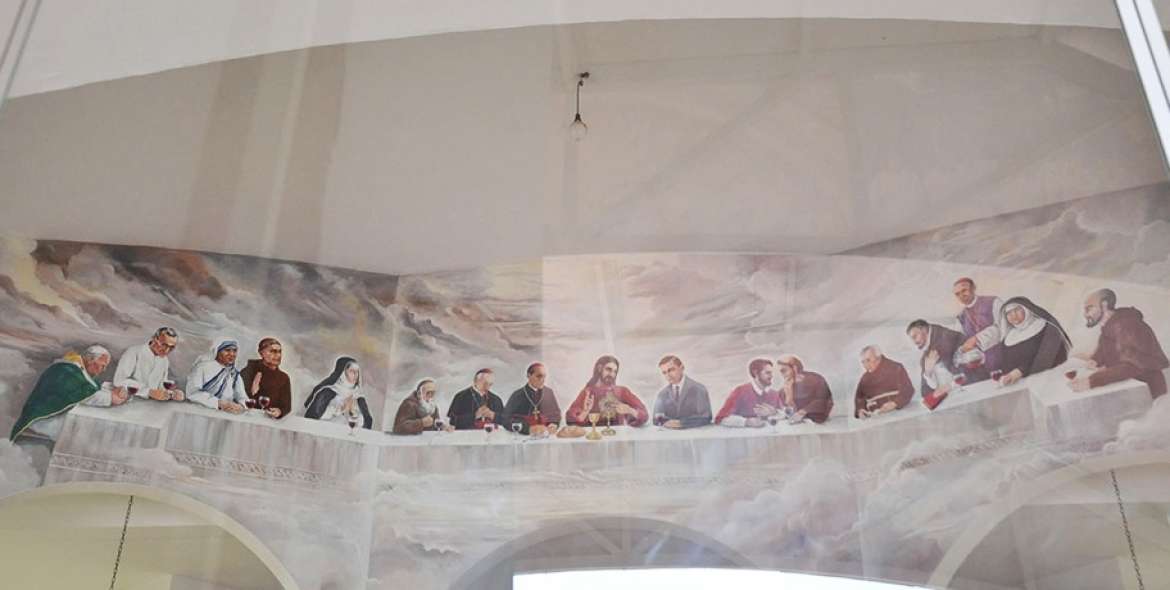
And with each visit (it is now only half an hour from my new home in Varazdin county, new discoveries. I learned about the Vatican-authenticated Eucharistic Miracle of Ludbreg on my first visit, but it was only later that I realised that this is, in fact, the only authenticated miracle in Croatia, and you can visit it. It is an incredible story of three churches, one of which the Croatian Government promised to build a church of thanks in the miracle town in 1788 if God stopped an approaching plague. While God kept his side of the bargain, it took Croatia more than 200 years to build the church, as recently as 1994 in the middle of the Homeland War. It is a fascinating story, and there is a certain irony in that an increasing number of Polish pilgrims spend the night in Ludbreg (the authenticated miracle town), en route to Medjugorje, where nothing has been officially acknowledged.
Coming from Dalmatia, the home of superb wines, including the original Zinfandel, I was surprised to find such a vibrant wine scene in places like Ludbreg. Or one so organised. While Dalmatia, despite its huge potential, still does not have a proper wine road, its winemakers far from united, Ludbreg boasts its own little wine road, as well as excellent cooperation between the winemakers, which manifests itself in the Ludbreg Wine Association, Trsek.
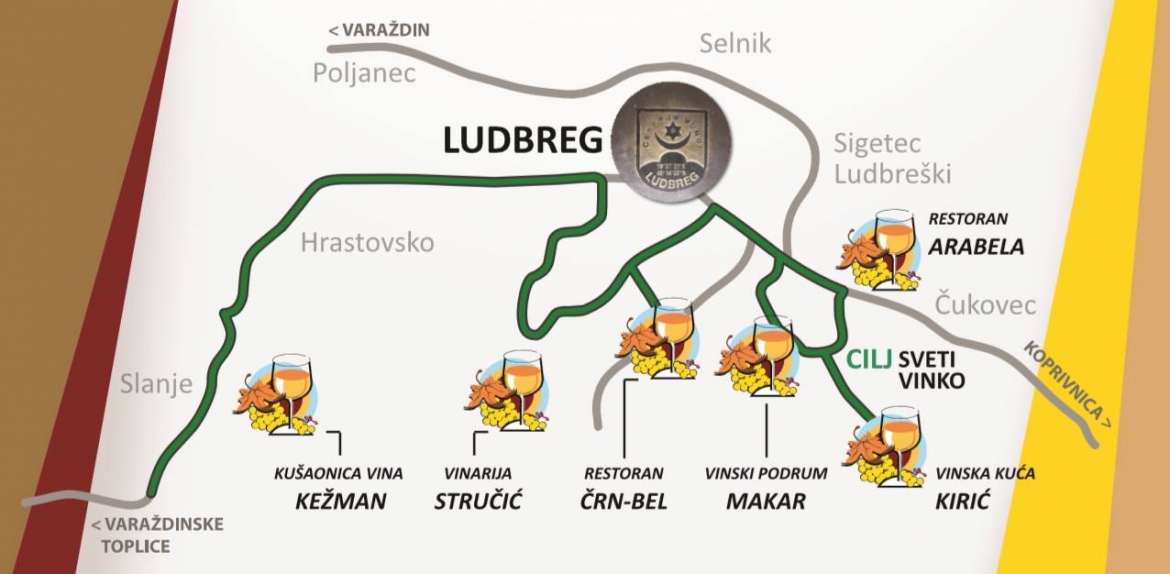
I was in Ludbreg on Thursday, where I learned another interesting fact about this unusual town - it has the biggest international exhibition of young wines in Croatia. E-Varazdin reported on the press conference in Ludbreg promoting the exhibition, a translation of which is below.
The 28th International Young Wine Exhibition titled "Vincekovo 2020", the biggest young wine exhibition in Croatia will be held on January 31st in Ludbreg.
The exhibition opening will be held at 5 pm at the Crnković hotel, after which the medals and awards will be presented. The visitors will be able to enjoy over 500 samples of young wine from all over Croatia, but also from Slovenia and Hungary, including those wines which have received the highest grades from the jury. The show was presented in the Crnković hotel by County Prefect Radimir Čačić, Ludbreg mayor Dubravko Bilić and President of the winemakers association from Ludbred Branko Kežman. This is the first year the exhibition will be titled "Vincekovo", and it will receive strong support from the County and the town of Ludbreg.
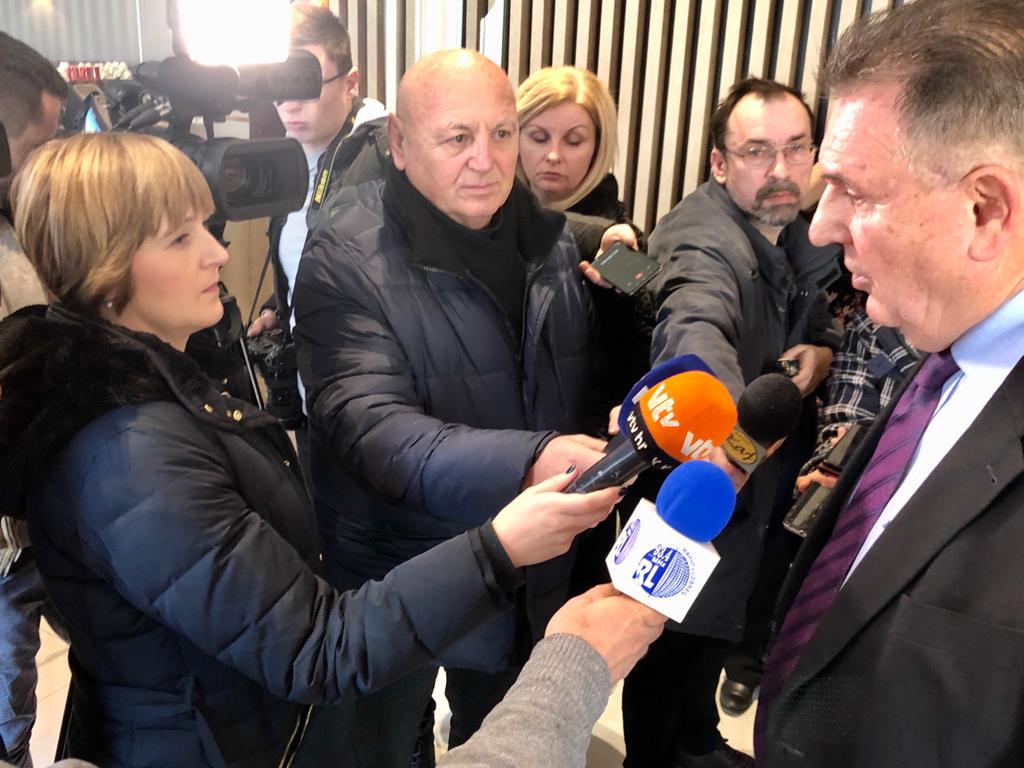
County Prefect Čačić said that around 500 samples of wine remain in the competition, after a fierce selection, which shows that the competition is strong, and the exhibition relevant. This is a region where modern, fresh wines of low alcohol and higher acids are made, and such wines are currently a global hit. Varaždin County is not a significant wine producer, as only between 1.5 and 2 per cent of Croatian wines are made in the County. However, the wines produced in the County are high-quality, which have recently been recognized on the global level, and Čačić said he expected around 10 to 15 wines made in the County to appear in the international competitions. And he also expects this exhibition to grow, and within 5 to 6 years it should be the best the County has to offer on Croatian and European level.
Ludbreg has always been connected to wine, and in the last 20 or so years people find the ways to make money and present their region by making good wines, mayor Bilić said. This exhibition was a learning experience for many local winemakers, who have learned in the past 28 years how to make excellent wines, and now the time has come for the winemakers to get together and start creating a brand of Varaždin County wines. Ludbreg exhibition of young wines has become international, so this is another opportunity for the winemakers to create the tourist story that lasts throughout the year, that will benefit everyone. It's an opportunity for them, as tourists are looking more and more towards continental Croatia, and there is the potential to provide enjoyment for all the senses. Mayor Bilić confirmed the Prefect's words, that while they are small, they need to be excellent at everything they do.
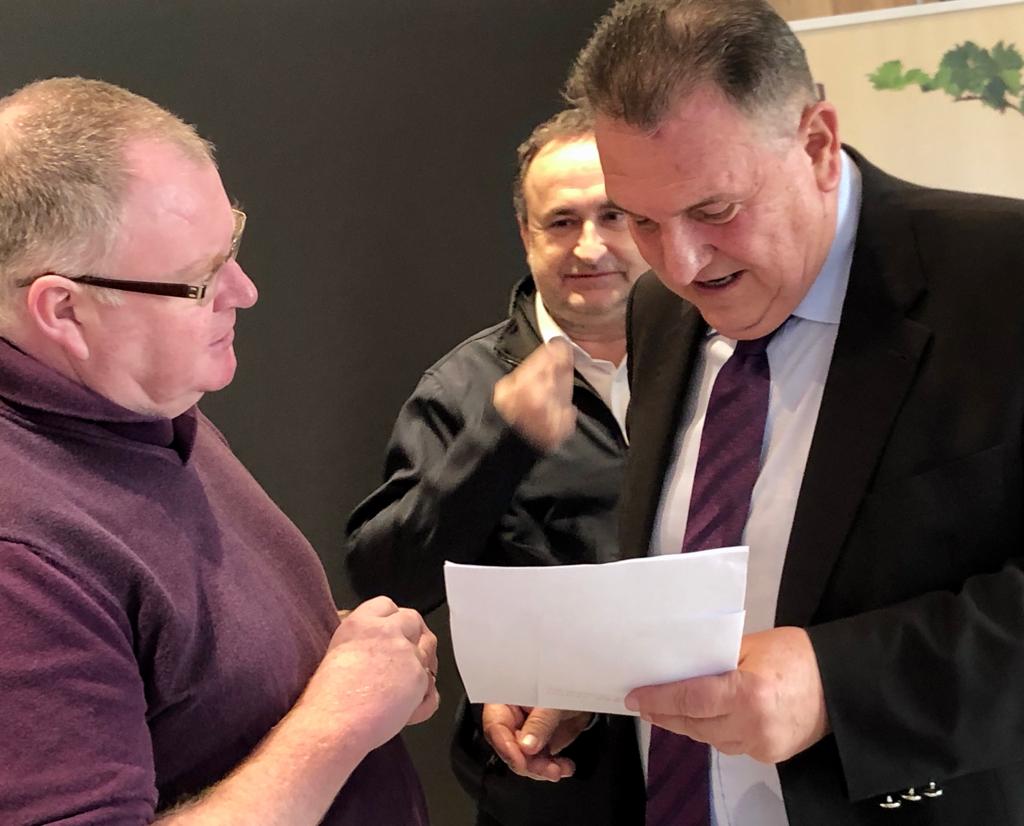
(TCN with Varazdin County Prefect Cacic and Ludbreg Mayor Bilic)
Almost thirty years ago, when the first exhibition was held in Ludbreg, the winemakers were in charge of grading the wines. These days the top experts do that work - enologists and sommeliers from Croatia, Hungary and Slovenia. Most of the wines at the exhibition are blends, and varietal wines are mostly Graševina, Rajnski Riesling and there's an increasing number of Moscatto wines, Branko Kežman from the Winemakers association from Ludbreg explained.
To follow the latest from Ludbreg, check out the dedicated TCN section.
Meet the Wine Roads of Croatia: Ludbreg in Varazdin County
December 20, 2019 - Some regions are better organised for wine tourism than others in Croatia - meet the Ludbreg wine road.
Living on a beautiful island of wine on Hvar, as I did for many years, in a picturesque region of Dalmatia whose wines are exported all over the world, I was constantly amazed that there are no official organised wine roads, as this is surely a great opportunity not only for tourism but to develop and promote one of the strongest aspects of life in Dalmatia.
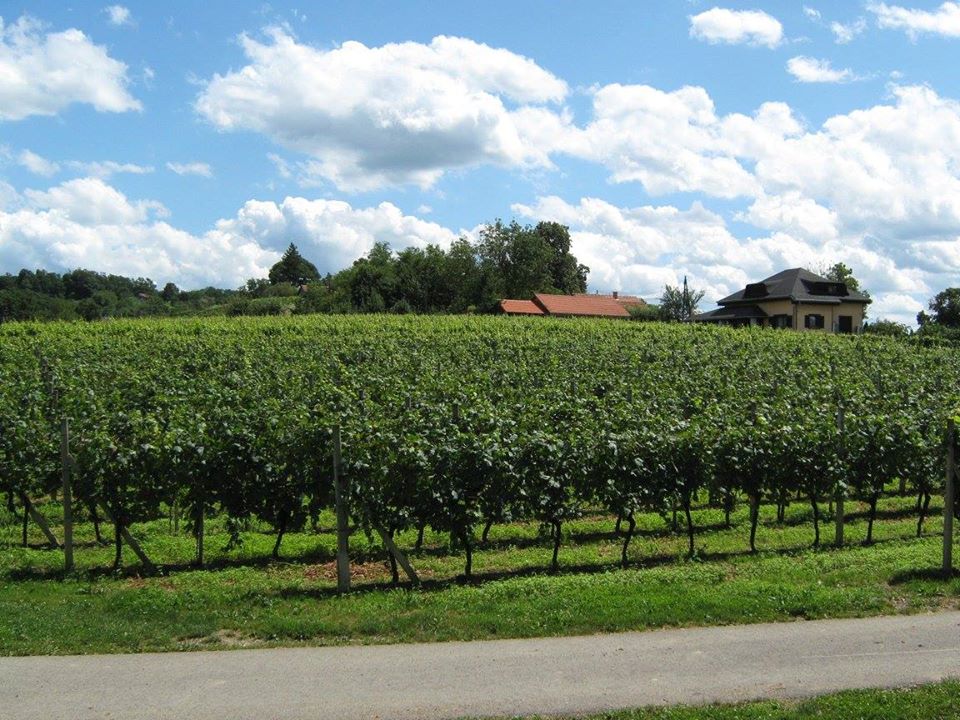
Cross the border into neighbouring Bosnia and Herzegovina, for example, and the first sign that you see is promoting the wine road of Herzegovina. And so too, all around Croatia, but sadly not in Dalmatia - at least for now. Things are a little more organised elsewhere in the country, including a very cute corner of northern Croatia, where white wines are king, and the closest vineyards to the centre of the world - Ludbreg in Varazdin County, which I first visited a few years ago. I was immensely impressed by the effort put in by enthusiastic local winemakers and restaurants to create the Ludbreg Wine Road, as well as the quality of the wines themselves. In their own words (a translation of their Facebook page, which you can follow here):
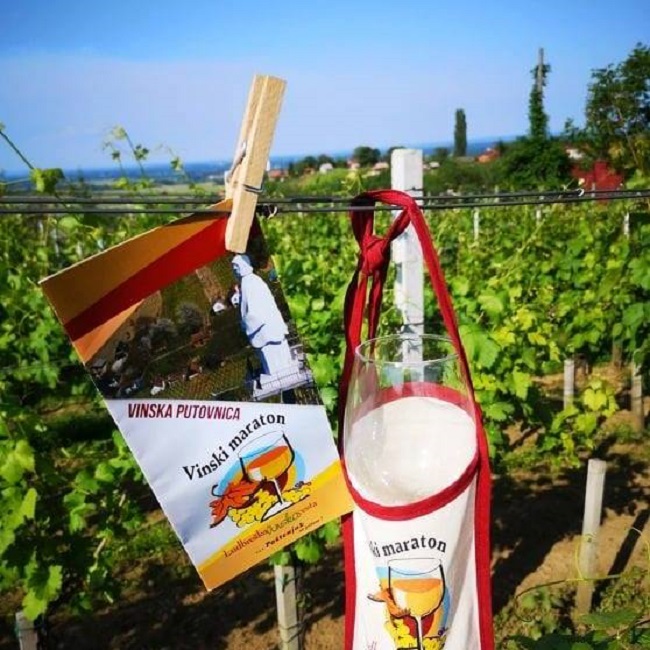
Once upon a time, in the 12th century, in the hills above Iovia (Ludbreg) lived a beautiful Ludberga. She was a skilled winegrower and she always worked hard in her vineyard and produced her famous sweet wine. At that time, everyone knew about Ludberga’s wine and beauty. As the years passed without Ludberga, Iovia’s Hills (the Ludbreg Winegrowing Area) were slowly forgotten. Wishing to restore the Ludbreg Winegrowing Area to its former lustre, the Ludbreg Wine Road was established.
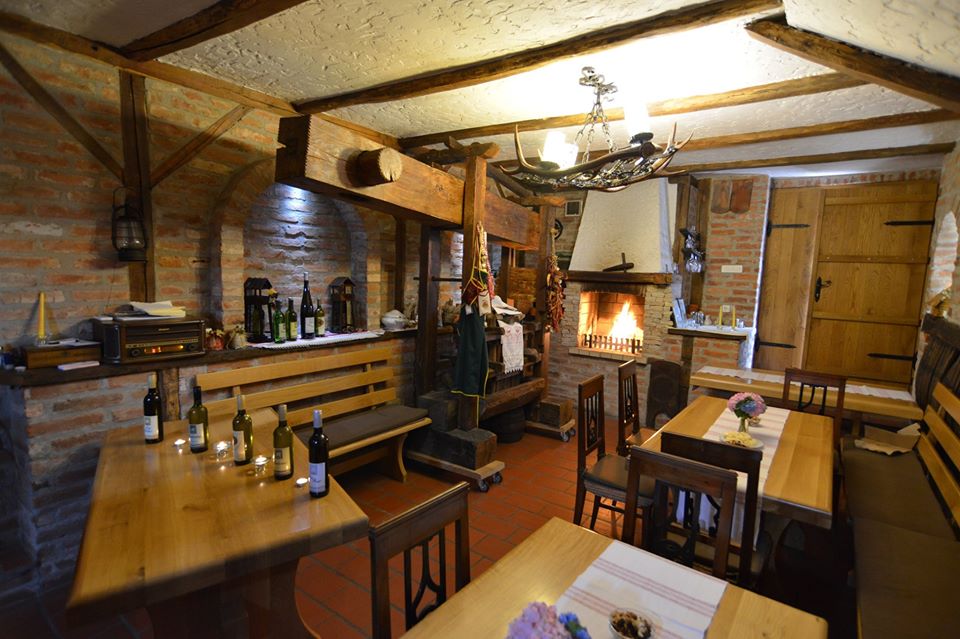
The Ludbreg Wine Road is located on the hills of the Ludbreg Winegrowing Area, which is an integral part of the Zagorje-Međimurje sub-region in the Continental Croatia Winegrowing Region.
The aim and purpose of the association is to promote wine tourism and its tourist presentation through a comprehensive wine area whose wine road includes wine checkpoints (wine-houses and cellars), and thus expands and stimulates the development of tourism, not just in the Town of Ludbreg, but also in the entire Ludbreg area and beyond.
The Ludbreg Wine Road includes: Restaurant/Tasting Room “Arabella” Globočec, Wine Cellar “Makar”, Wine House “Kirić”, Restaurant “Črn-Bel”, Winery “Stručić”, and Tasting Room “Kežman”.
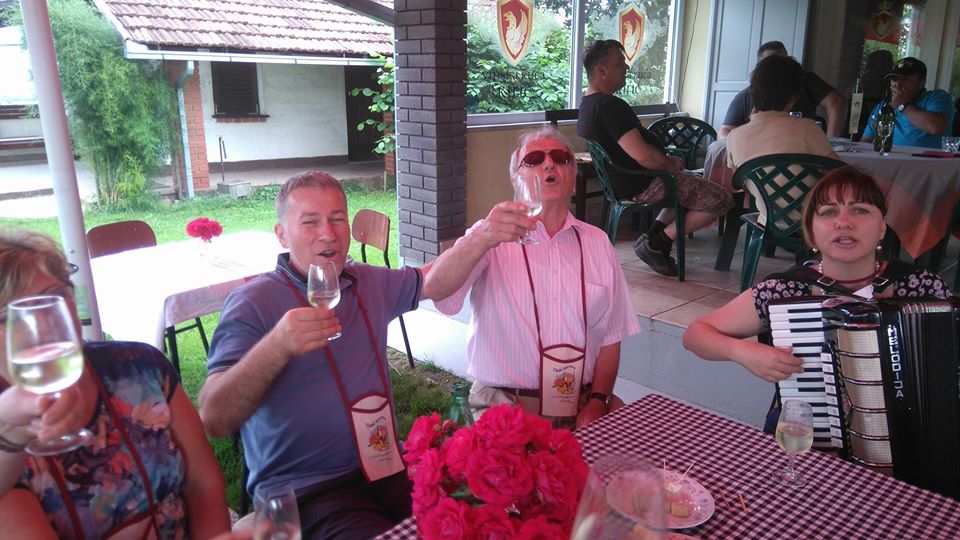
Here you can try: Graševina, Riesling, Pinot Blanc and Pinot Gris, Sauvignon, Green Silvanac, Chardonnay, Traminac, Moslavac and Manzoni, Muscat and Pinot Noir, Frankovka, Cabernet Sauvignon and, of course, our Poštenjak. In addition to the wines, the offer includes authentic “hilly” delicacies from the Ludbreg area.
Poštenjak, or “wine without malice”, is a quality wine that contains 70 percent of Graševina, 20 percent of Chardonnay and 10 percent of Pinot Gris. The wine is named after a popular character, honest and naive Dudek from the Croatian TV series “Gruntovčani”, written by screenwriter Mladen Kerstner, who was originally from Ludbreg.
The Ludbreg Wine Road includes a statue of St. Vincent with a viewpoint. This statue of St. Vincent is the tallest such statue in Croatia and even in the world, and offers a view of Varaždin County, Koprivnica-Križevci County, Međimurje County and neighbouring Hungary.
Also, we always take care of cleanliness and environmental protection of the area around the wine road.
So, if you would like to taste or drink a glass of wine and try some “hilly” delicacies, you can find us in the very centre of the world.
Learn more about the wines of Lubreg in the video below from G.E.T. Report (in Croatian), and to learn more about one of the most fascinating towns in all Croatia, check out TCN's visit to Ludbreg here - amazing place.
Iovia Ludbreg Video: Centre of the World Connecting Heritage Through Time
November 16, 2019 - The small northern Croatian town which calls itsself the centre of the world is expanding its tourism offer with a journey back through time. Meet Iovia Ludbreg.
Ever since I visited Ludbreg for the first time more than three years ago, I have been mildly fascinated by the little town of Ludbreg, which sits in eastern Varazdin County equadistant from Varazdin and Koprivnica. At the time, I recorded my first impressions in Ludbreg, the Most Fascinating, Unusual Little Town in Croatia? And it is.
And while most Croatians will know Ludbreg for its claim to be the centre of the world, a little closer investigation of its religious history reveals that it could soon be better known for something which potentially could attract a lot of religious tourists. For as we explored recently, it seems that Ludbreg is Croatia's only official miracle town. The only place in all Croatia which has a miracle verified by the Vatican which you can actually visit. By contrast, Medjugorje in neighbouring Bosnia and Hercegovina has nothing officially recognised by the Vatican and yet attracts over a million tourists a year. You can lean more about the Ludbreg miracle here.
Not content with the current tourist attractions on offer, the local authorities are working hard to improve the tourist offer in the town, with the latest initiative unveiled last week by video called Iovia Ludbreg.
It is a presentation of the project "Improving the continental tourism by the tourist recognition of the historical and cultural heritage of the town of Ludbreg" - Iovia Ludbreg.
In the video, they explained the current situation in Ludbreg: the religious tourism in the town is developed, as it is a well-known pilgrimage site. The number of visitors is growing, as is the understanding that religious tourism is important for a wider community, not just the town itself.
The project's basic idea is to create an archaeological park and show as clearly as possible the thousands of years of continuous inhabitation of the area, which was first inhabited in prehistory. It is important to focus on attracting more visitors to Ludbreg and surroundings, and that can be done by putting together the information on the possibilities for visitors.
Improving the existing cultural heritage, as well as building the new tourist offerings for the visitors will achieve just that. That can be done through an integrated project, along with the appropriate marketing activities. And that is exactly what is being achieved in the project "Improving the continental tourism by the tourist recognition of the historical and cultural heritage of the town of Ludbreg".
A part of the project is to build the archaeological park "Iovia Ludbreg" in the centre of the town, which is often called "the centre of the world".
Erina Stančin, the project manager, explains that currently all of the explored walls are being restored to the height of 110 cm, while the Roman walking surfaces will be restored to their original height. Info boards with 3D reconstructions of the entire site will be installed, to make it easier to understand the architecture of the site. There will be tents situated on the site, with Roman games, which will be open year-round. On the Southern side of the site wooden benches will be situated to mimic Roman theatre. That will create a setting for lectures and open-air classes.
Somođi house, the only existing building on the site, will become a multifunctional object with an area of around 670 m2. Somođi garden is being created next to the house, so a lot of work is being done there – construction, decoration, landscaping. Erina Stančin adds that shortly the Somođi house will become the centre of cultural and tourist events in Ludbreg. It will be able to receive around 150 visitors, and their number will be monitored. There will be a souvenir shop and an exhibition which will show the history of Ludbreg from prehistory until modern times. A multimedia presentation space will also be created, in which 3D interactive models will show the researched parts of Roman Iovia. Multifunctional hall will be in the basement, to be used by associations of civil society for their educational or entertaining events.
Hotel "Crnković" was also adapted through this project. Soon it will offer 15 rooms (30 beds) and great food. Boris Crnković, the owner, says that the hotel will add to what Ludbreg has to offer to the bigger number of visitors. 85 per cent of the money needed for the complete adaptation came from the project, while 15 per cent are their own funds.
A walking trail along Bednja will also be created, 1300 meters long with informational and educational content, bringing other locations and sites closer. A new square, the so-called "Crafter's Square" will also be built, and it will be a location where the visitors will be able to learn about the crafts present during the Roman period. The Most Holy Trinity Church is the central and key point of the Ludbreg sanctuary. It will also get some attention through this project, as works on the facade will be done and a system of monitoring the number of visitors implemented.
To follow the latest on Iovia Ludbreg and news from the centre of the world, follow the dedicated TCN section.


